Ho Chi Minh City offers a mix of French colonial architecture and Chinese influences with numerous temples. A visit to Notre Dame cathedral, Post Office, and Ben Thanh market showcase the city's unique culture. A day trip to My Tho on the Mekong River and Tay Ninh's Cao Dai temple offer insight into Vietnam's history, including the Cu Chi Tunnels used during the Vietnamese-American War.
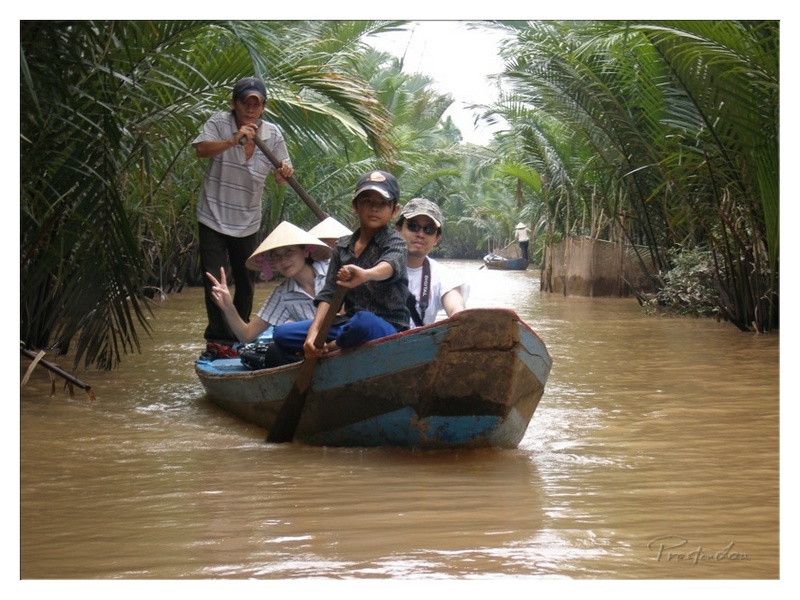

Jungle Cruise: The Budget Edition
Subject Rating: 7/10
Ah, the classic tropical river adventure shot! Here we have a lively boat ride through what appears to be the dense, palm-lined waterways of Southeast Asia. Our subjects are a motley crew – a determined-looking chap expertly navigating from the rear, a young adventurer front-and-center, a passenger striking a peace sign (gotta get that vacation proof!), and another person partially visible, sunglasses firmly in place. The mood is definitely one of slightly bumpy but ultimately fun exploration, with the rich, muddy water serving as both the path and the foreground element. Objects of note include the sturdy, if somewhat weathered, wooden boat and the iconic conical hat adding that perfect touch of regional authenticity. The background is a lush, green wall of palm fronds, creating a tunnel effect that emphasizes the feeling of being deep within the jungle, with just a hint of another boat and some intriguing fishing nets or structures visible further down the waterway.
From a photography perspective, this shot captures the scene effectively, though perhaps a tad too busy. The composition places the boat and its occupants squarely in the center, which works, but a touch more negative space or adherence to the rule of thirds might have given it more breathing room. The lighting is soft and diffused, which is kind to skin tones and avoids harsh shadows, though it leaves the scene a bit flat; a stronger directional light could have added more depth and texture, especially to the water. The color palette is dominated by the earthy browns of the water and the vibrant greens of the palms, grounded by the blues and whites of the boat and clothing – a classic tropical scheme, if a bit muted. Capturing a clear image on a moving boat is always a win, and the focus is sharp enough on the main subjects. One minor critique for the catalog? That watermark is a bit aggressively placed right over the water texture – a quieter corner might have been better for the post-processing notes. Overall, a decent capture of a fun, slightly cramped river journey, ready for the archives!
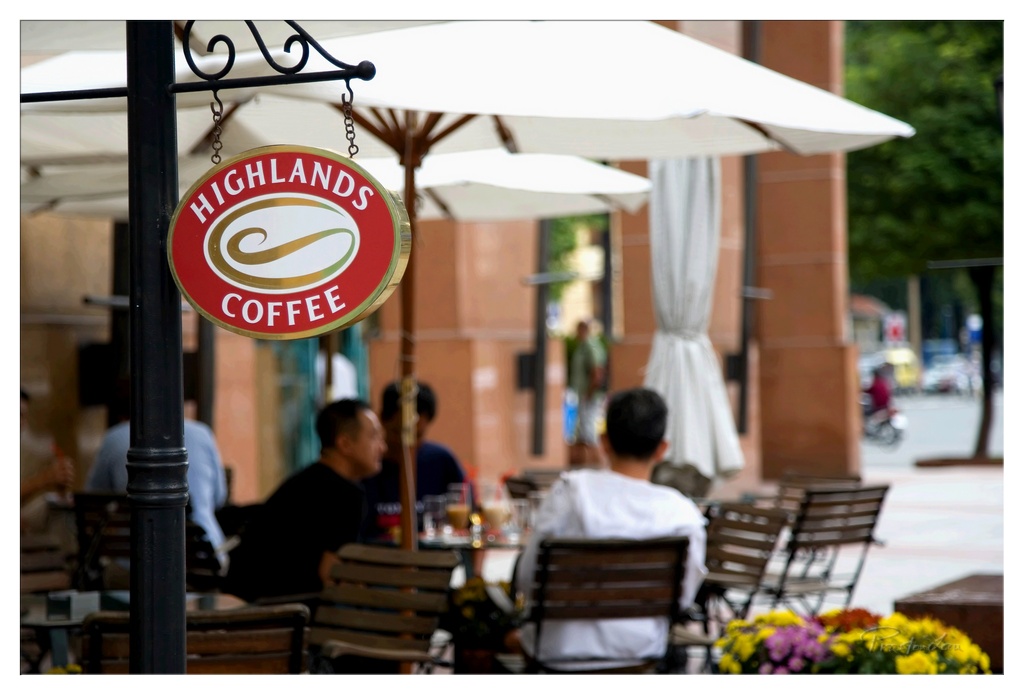

Coffee Break Under the Umbrella Sky
Subject Rating: 8/10
Ah, Highlands Coffee, proudly announcing its presence like a caffeinated beacon on a pole. This shot zeroes in on the crucial element – the sign promising that much-needed energy boost, or perhaps just a pleasant sit-down. We see a bustling outdoor cafe scene unfolding beneath a canopy of bright white umbrellas, creating a patchwork of shade and light. Various figures are seated at sturdy wooden tables and chairs, engaging in conversations or simply soaking in the atmosphere. The subject is rated 8/10 because while the sign is clear and the setting is identifiable, the people are largely obscured or blurred, which makes it more about the *place* than the individuals enjoying it. It’s a classic case of "proof of coffee shop existence" captured mid-afternoon, likely filled with the low hum of chat and the clinking of glasses.
From a photography perspective, the composition is cleverly anchored by the dark vertical pole and the prominent placement of the oval Highlands Coffee sign, drawing the eye immediately. The large white umbrellas serve a dual purpose – providing shade for the patrons and adding a significant visual element that dominates the upper half, almost like fluffy clouds grounding the scene. The photographer has employed a shallow depth of field effectively, ensuring the sign and the nearest tables are sharp while the background street scene dissolves into a pleasant bokeh blur of traffic lights, greenery, and buildings. This technique isolates the cafe environment from the urban rush behind it. The natural light is soft and even, diffused by the umbrellas, preventing harsh shadows on the immediate subjects. The color palette is warm and inviting, with the bold red of the sign standing out against the neutral whites and browns, punctuated by the cheerful yellow and purple flowers in the foreground, adding a touch of life and color contrast. It's a well-executed capture that feels both candid and intentional, perfectly conveying the relaxed vibe of an afternoon coffee break.
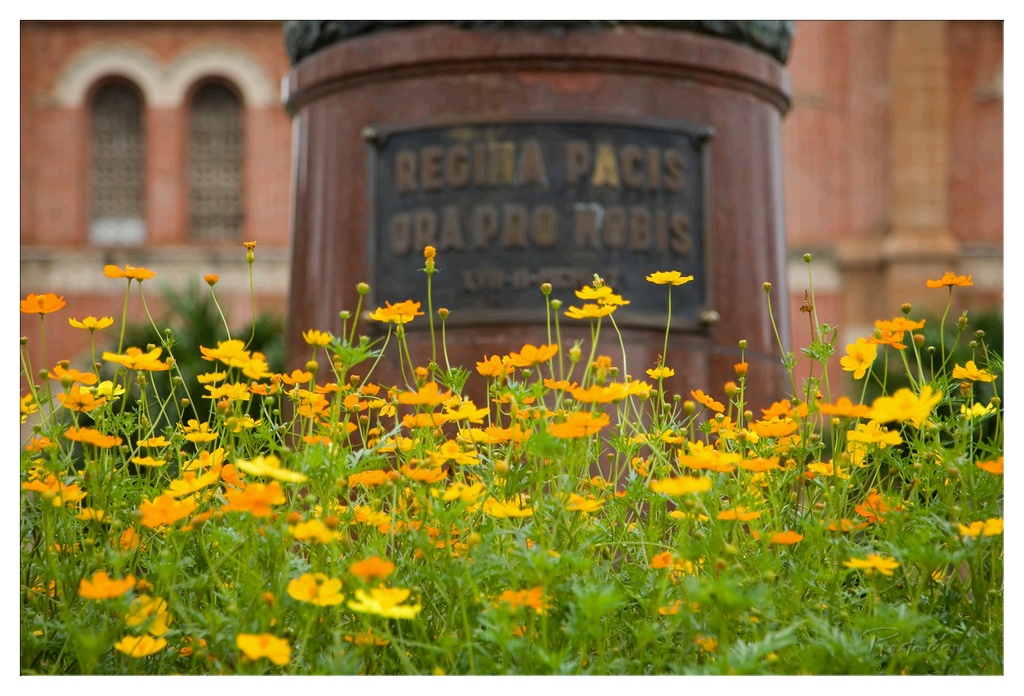

A Floral Prayer
8/10
This image presents a lovely contrast between the vibrant, wild beauty of nature and the stoic permanence of man-made structures and spiritual text. The foreground is a riot of bright yellow and orange cosmos flowers, their delicate petals and green foliage creating a soft, textured carpet. They appear to be bowing or reaching towards the large, dark stone pedestal standing firmly behind them. This pedestal bears a significant inscription in a metal plaque: "REGINA PACIS ORA PRO NOBIS," which translates to "Queen of Peace, pray for us," adding a layer of spiritual meaning to the scene. It's a peaceful moment captured, suggesting nature's silent tribute at the base of a monument dedicated to peace.
From a technical perspective, the photographer masterfully uses a shallow depth of field, ensuring the gorgeous flowers and the crucial inscription are pin-sharp while the red brick building in the background melts into a pleasing, out-of-focus blur. This draws the viewer's eye exactly where it needs to be – on the lively blooms and the poignant message. The lighting is soft and natural, beautifully illuminating the flowers and bringing out their warm, cheerful colors without creating harsh shadows, which is perfect for capturing such delicate subjects. While the pedestal is quite centered, the dynamic, organic forms of the flowers in the foreground prevent the composition from feeling too static. It's a thoughtful composition that highlights the symbiotic relationship between nature's transient beauty and the lasting weight of human endeavor and faith.
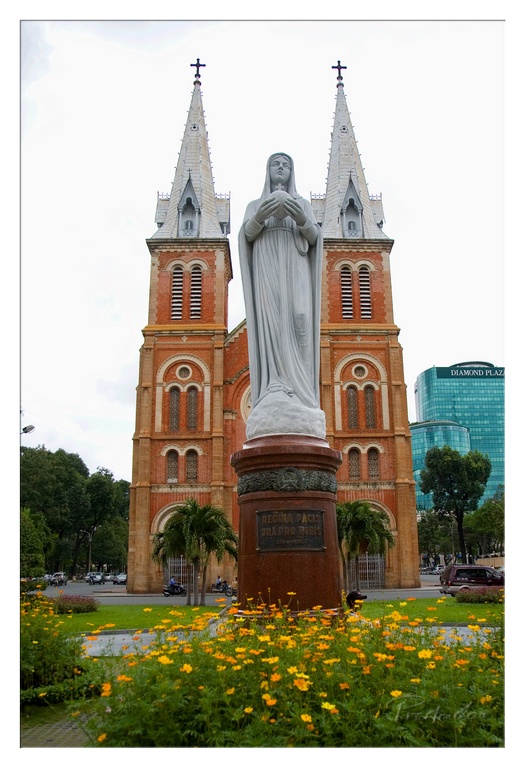

Mary Looks Upon the Concrete Jungle
Subject: 8/10
Standing tall before the historic Notre Dame Cathedral, a stoic statue of the Virgin Mary clutches a rather large globe, perhaps pondering the sheer volume of mopeds zipping past her feet in modern-day Saigon. It’s a classic shot of a prominent religious landmark, with the imposing twin spires of the brick church providing a grand backdrop for the central figure. The mood is intended to be reverent, but the inclusion of the glass-clad 'Diamond Plaza' building peeking out behind the church injects a dose of reality, reminding us that even sacred spaces exist within the ceaseless hum of urban development. One almost expects the statue to sigh and say, "Well, this wasn't in the original plans."
From a photographic standpoint, the composition attempts symmetry with the statue centered between the spires, a classic technique for creating balance, though the full height of the spires is slightly clipped at the top, a minor quibble. The foreground bursts with cheerful yellow flowers, providing a splash of color and depth, albeit a bit out of focus, which is a shame as they add a nice organic element to contrast with the stone and brick. The lighting is soft and even, thanks to the overcast sky – great for avoiding harsh shadows on the statue and building, but perhaps lacking a bit of dramatic punch that sunlight might offer. It's a straightforward, well-exposed travel snap that captures the scene effectively, showcasing the blend of old and new architecture, but it could benefit from either fully committing to the majestic architecture or leaning harder into the fascinating urban contrast. The white border is... a choice.
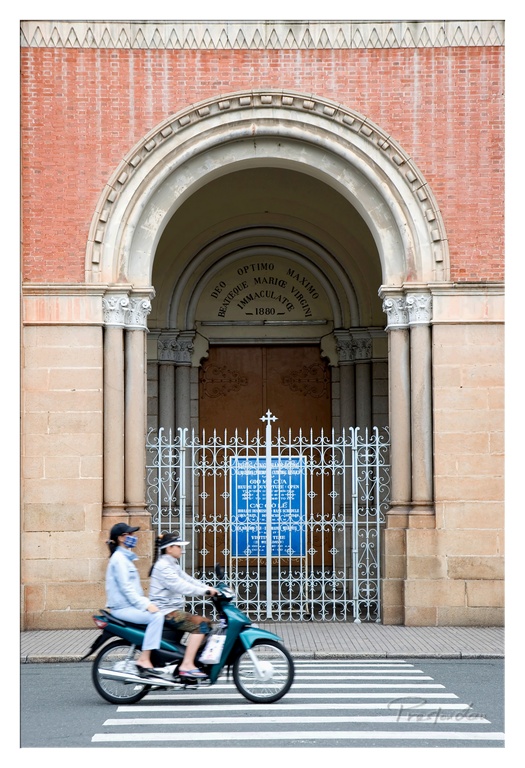

Scootin' Past Salvation
Rating: 7/10
Here we have a classic street photography juxtaposition, earning a respectable 7/10 for its brave attempt to marry the sacred and the mobile. Against the stoic, historic facade of what appears to be a rather grand church entrance – complete with arched doorways, Corinthian-ish columns, and what looks like Latin script saying "To God, Best and Greatest, and to the Immaculate Virgin, 1880" – two masked individuals zip across a zebra crossing on a teal scooter. It's a moment of modern urban rhythm playing out in front of centuries of stillness, capturing a specific point in time where masks are part of the daily commute, even past divine structures. The mood is one of quiet observation, the hustle of life momentarily intersecting with architectural permanence, creating a curious blend of timeless grandeur and fleeting, masked existence.
From a technical standpoint, the composition is vertically strong, centering the impressive archway and its inscription, while the scooter provides a dynamic horizontal element in the foreground, preventing the image from being *too* symmetrical and static. The soft, overcast lighting is kind to the brickwork, showing its texture without harsh shadows, and gives the scene a slightly muted, consistent color palette – the red brick, beige stone, and teal scooter playing well together, punctuated by the bright blue sign attached to the rather ornate metal gate. The photographer has clearly used a shutter speed just slow enough to introduce pleasing motion blur on the wheels and figures, highlighting their movement against the fixed background. It's a thoughtful capture, blending architectural detail with a slice of daily life, even if the subjects' faces are hidden by those very contemporary accessories, adding an unintentional layer of mystery to the scene.
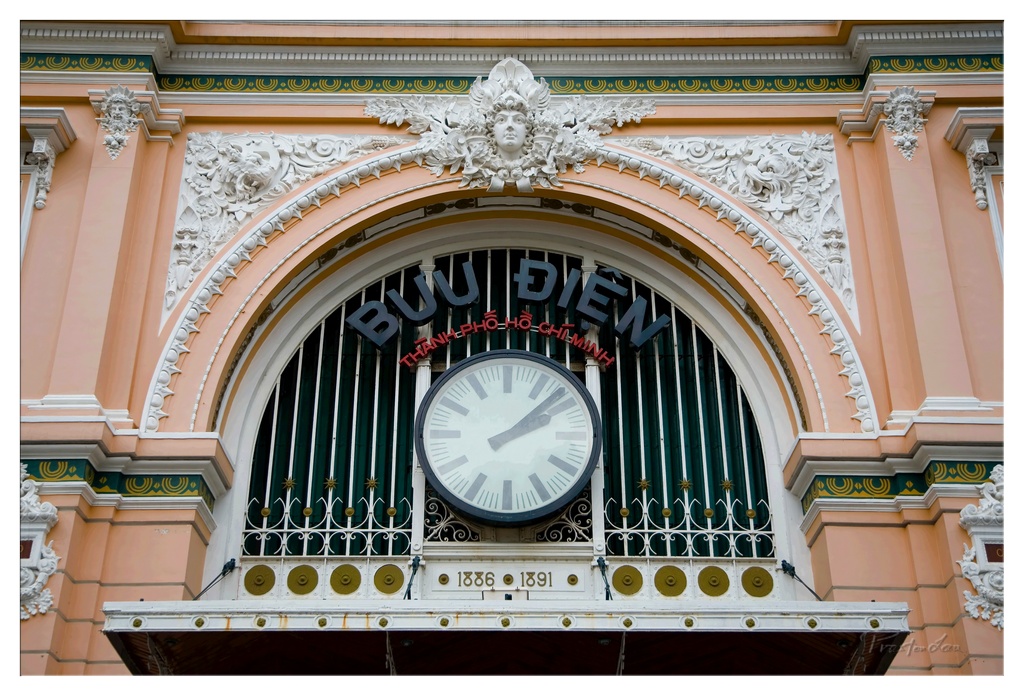

Grand Old Mail House
Rating: 8/10
Step right up and behold the architectural splendor of the Ho Chi Minh City Post Office! Rated a solid 8 out of 10 for its sheer visual drama, this image captures the magnificent central archway of the building's facade. There's no bustling postal action happening here, just the stoic presence of ornate European colonial architecture, standing proud in a soft peachy-pink hue accented with crisp white plasterwork and dark green detailing. The mood is one of historical grandeur and slightly faded elegance. Dominating the arch is the sign "BUU DIEN THANH PHO HO CHI MINH" (that's Ho Chi Minh City Post Office for us non-Vietnamese speakers), nestled above a substantial, almost intimidatingly large clock. Below the clock, the construction dates "1886 1891" are proudly displayed, reminding you this place has been handling mail (or at least looking fabulous) for over a century. Look closely and you'll find a rather stern-looking face sculpture centered above the arch, perhaps guarding the postal secrets within, flanked by elaborate floral and foliate carvings that seem to drip down the facade like frozen icing.
From a photography perspective, this shot nails the symmetrical composition, drawing the viewer's eye directly to the central arch, clock, and sign. The lighting is wonderfully soft, likely overcast or early/late day light, which gently illuminates the intricate details of the white plasterwork without blowing out highlights or casting harsh shadows – perfect for showcasing texture. The color palette is warm and inviting, anchored by the distinct peachy walls and contrasted by the cool green and crisp white. The choice to focus tightly on this section highlights the incredible detail often missed from a wider view. The background here *is* the building itself, a richly textured canvas of carvings, patterns, and solid forms. It’s a classic example of architectural portraiture, capturing the essence of the structure's most characterful feature, making you appreciate the craftsmanship that goes into even sending a postcard. Though, I suspect that face above the arch is judging how long it took you to get around to mailing that letter.
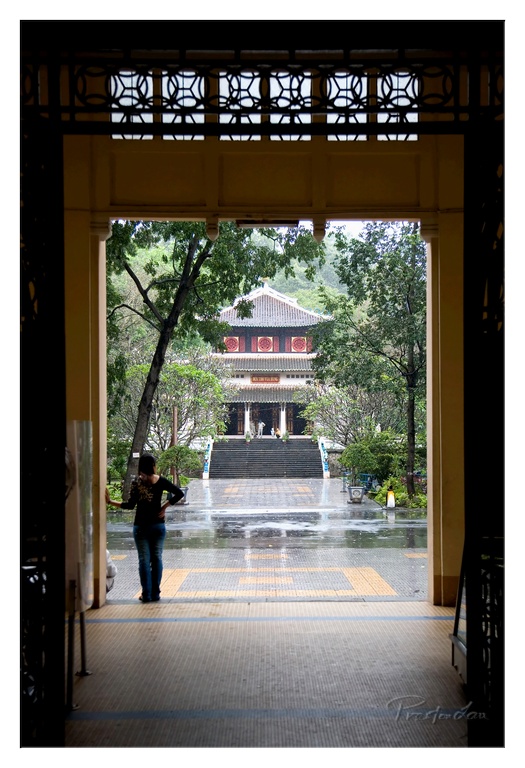

Framed Temple View in the Rain
Rating: 8/10
Ah, the classic "looking out from under cover" shot – a timeless way to capture the misery and beauty of a rainy day simultaneously. Our intrepid subject, perhaps contemplating the meaning of life or just wondering if they left the umbrella in the car, stands perfectly framed by this rather impressive doorway, providing scale and a touch of human drama to the scene. The world outside is a wash of gray and green, the wet ground reflecting the soft, diffuse light, giving everything a slightly melancholic but undeniably atmospheric glow. In the distance sits a beautiful multi-tiered temple, its intricate design and red accents standing out against the lush, rain-soaked foliage and the looming hillside behind it. It’s a quiet moment, punctuated only by the imagined sound of raindrops on the pavement.
From a photographic perspective, this image nails the framing, using the strong architectural elements of the foreground structure to create a natural vignette leading the eye towards the main subject in the distance. The composition is balanced, with the person slightly off-center but countered by the weight of the temple. The lighting, though challenging with its flatness, perfectly captures the feeling of a damp, overcast day, highlighting the sheen on the wet paving and the muted greens of the trees. The color palette is subdued but effective, relying on the natural tones of stone, wood, and vegetation, with the temple's vibrant reds offering a welcome splash of warmth. It’s a well-executed capture of a specific moment and mood, proving that even less-than-ideal weather can yield compelling imagery, provided you find a nice doorway to hide in. Bonus points for the visible (and slightly damp) signature adding a personal touch.
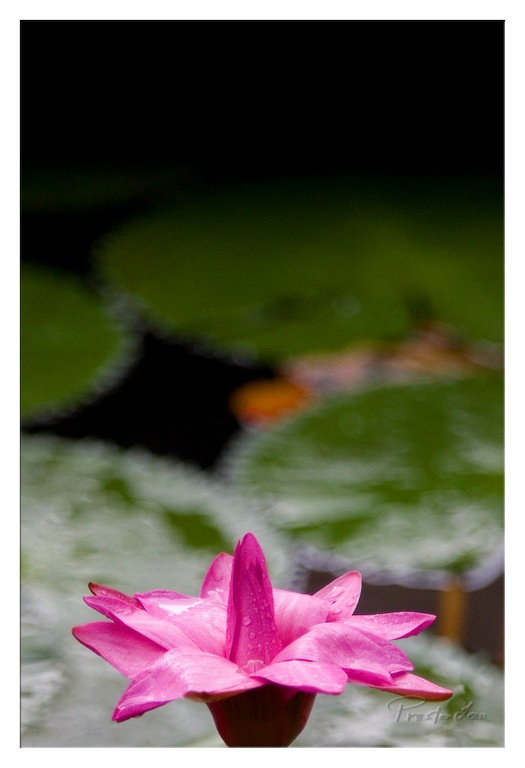

Ascending Bloom in Vertical Vogue
Rating: 9/10
Behold, a solitary pink water lily, seemingly attempting to defy gravity by reaching straight up, as if aspiring to become a terrestrial flower and escape the pond life hustle. It stands prominently in the lower part of this decidedly vertical composition, its vibrant petals glistening with water droplets, giving it a fresh-from-the-shower look – perhaps it just emerged from a refreshing dip, unlike us who often look less than glamorous after a splash. The subject matter is classic, but the close-up perspective isolates this individual bloom, granting it star status. The mood is one of serene focus on the delicate beauty of the flower, juxtaposed with the slightly mysterious, dark water beyond the lily pads, hinting at deeper complexities beneath the surface (or maybe just more mud).
Technically speaking, this shot employs a shallow depth of field masterfully, rendering the background into soft, ethereal blobs of green and dark shadows, ensuring our eye remains firmly fixed on the sharply detailed pink protagonist. The lighting appears soft, perhaps overcast or late in the day, which brings out the rich color of the petals without harsh highlights, and makes those tiny water beads sparkle like miniature diamonds. Compositionally, placing the flower low in the frame creates a sense of upward movement and leaves ample space for the abstract background, which is a risky but effective choice in this vertical format. It’s a clean, focused style that says, "Look at me, and only me," perfect for highlighting the simple elegance of nature, though it might leave you wondering what drama was unfolding just beyond that blurry green stage.
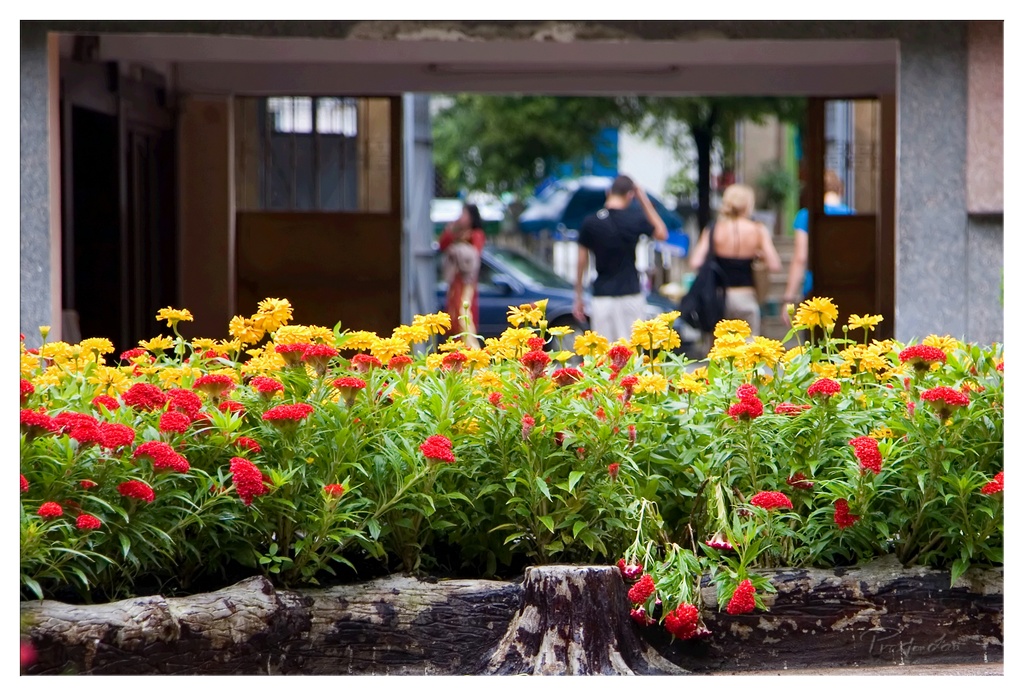

Petal Prowlers and Blurry Backdrop
Subject Rating: 9/10
This photo presents a vibrant explosion of nature attempting to steal the show from the hustle and bustle behind it. In the foreground, a robust wooden planter box, looking perhaps like salvaged logs, hosts a lively party of bright red Celosia flowers and cheerful yellow Zinnias, their lush green foliage creating a dense, colorful barrier. It's as if they're saying, "Look at us! Forget the blurry drama!" Behind this floral barricade, framed by a plain archway, a street scene unfolds, but intentionally kept soft and out of focus. Blurred figures, a dark car, and hints of buildings and trees suggest a busy urban environment, offering a stark, almost indifferent contrast to the meticulously detailed beauty of the flowers. The mood is one of focused beauty juxtaposed with a generalized, distant reality – a vibrant foreground commanding attention while the background melts into anonymity.
From a photographic perspective, this shot is a masterclass in using shallow depth of field to isolate the subject. The composition places the flowers front and center, dominating the lower two-thirds of the frame, while the archway provides a natural, albeit unsharp, frame for the background activity. The lighting appears natural and even, perfectly illuminating the rich hues of the red and yellow petals, making them pop against the softer green and the muted background tones. The color contrast is the real star here, drawing the eye immediately to the foreground fiesta. The photographer has clearly prioritized the textural and chromatic richness of the flowers over capturing sharp details of the human subjects or the streetscape, effectively turning the background into a supporting abstract wash of color and motion. It's a great example of finding a moment of static beauty amidst potential chaos.
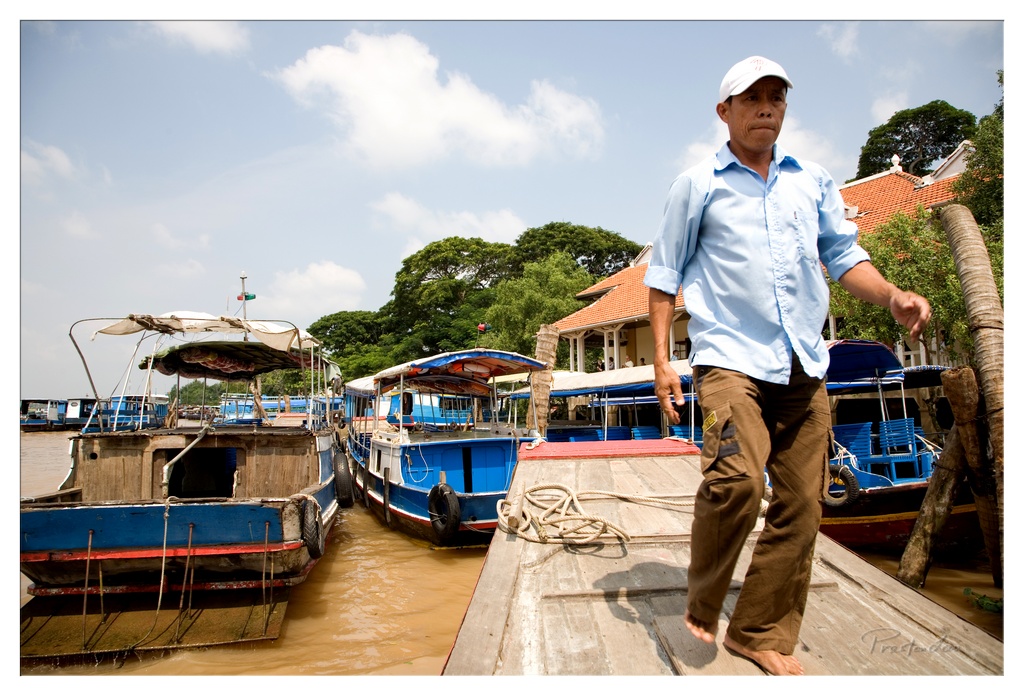

Dockside Stride
Our subject for today, a gentleman in a crisp light blue shirt, practical brown cargo pants, and a classic white cap, strides confidently along a weathered wooden deck. He's walking towards us, barefoot on the planks, perhaps just stepping off or onto one of the many boats tied up here. The scene unfolds at what appears to be a bustling river landing, populated by an assortment of sturdy blue-hulled vessels, some topped with makeshift canopies, bobbing on murky brown water. In the background, lush green trees frame a building with a distinctive orange tiled roof under a bright, partly cloudy sky, suggesting a warm, perhaps humid, day.
Giving our barefoot navigator a solid 8/10 for sheer photographic potential – he's got character, movement, and doesn't demand awkward poses! The composition here is nicely anchored by his off-center placement, using the diagonal lines of the dock to pull the eye in. The lighting is classic mid-day harsh, but it highlights the textures and colors effectively, making those blue boats really sing against the suspiciously chocolatey water. It feels very much like a candid travel snapshot; the photographer captured a moment of authentic daily life without fuss. Style-wise, it's documentary meets postcard, giving us a slice of this vibrant, working waterway. My only critique? The leading edge of the foreground boat is a *tad* cut off, but hey, nobody's perfect, right? Just like that water color!
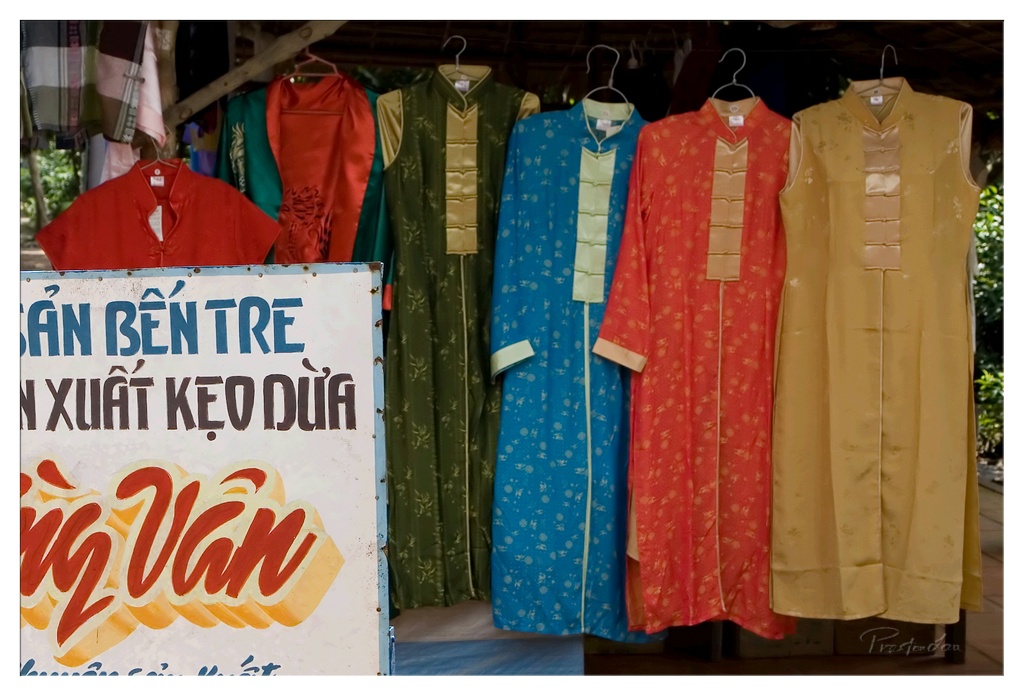

Marketplace Hues
Subject Rating: 7/10
Stepping into a vibrant scene, we find ourselves facing a display of what appears to be traditional Vietnamese garments, likely elegant Ao Dai, hung neatly on hangers. These colorful dresses – a lush green, a bright patterned blue, a warm coral red, and a soft golden yellow – are the main attraction, showcasing intricate patterns and delicate textures. To the left, a large, slightly distressed sign with bold lettering in Vietnamese adds a strong sense of place, hinting at the local commerce happening here, perhaps selling something related to "Bến Tre" and "kẹo dừa" (coconut candy), if the translation serves correctly. There's also a lone red short-sleeved top making an appearance on the far left, adding a casual touch to the more formal long dresses. The overall mood is lively and authentic, capturing a moment of everyday life in a market or roadside stall.
From a photographer's standpoint, this image is a study in color and local character. The rich, saturated hues of the dresses are the stars, beautifully contrasted by the stark white and blue of the sign. The natural lighting seems soft and even, highlighting the fabric details without creating harsh shadows. Compositionally, the inclusion of the large sign on the left is a bold choice; while it provides crucial context and a rustic feel, it does vie for attention with the garments themselves, making the frame feel slightly unbalanced. It's almost as if the sign is trying to sell itself as much as the clothes! The out-of-focus background, showing glimpses of greenery and structural elements, helps isolate the subjects, maintaining focus on the colorful display and the intriguing signage. Despite the slightly cluttered composition, the image successfully conveys the atmosphere and visual appeal of this small slice of marketplace life.
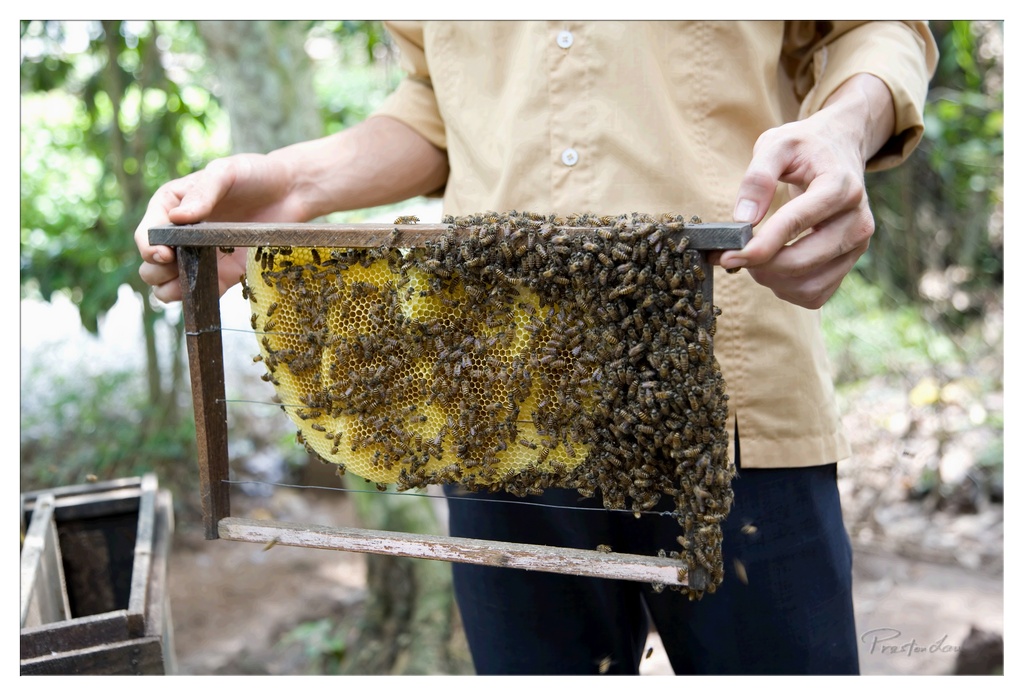

The Handshake with Nature's Buzz
Subject Rating: 9/10
Forget shaking hands with a stranger, this is a true test of nerve and partnership: a human hand carefully supporting a thriving metropolis of bees! The image captures a pivotal moment in beekeeping, where the beekeeper (or brave volunteer) presents a frame absolutely teeming with honeybees busily working their hexagonal magic on the honeycomb. The mood is one of focused observation, a quiet communion between man and insect, only slightly offset by the inherent tension of being surrounded by thousands of potential stingers. It's a fascinating, if slightly unnerving, display of the complex world inside a hive, highlighting the incredible density and constant activity of a healthy colony.
From a photographic standpoint, the composition cleverly places the hands and the bee-laden frame squarely in the middle, drawing the viewer's eye immediately to the incredible density of the bee colony. The shallow depth of field is a fantastic choice, rendering the background into a soft, painterly blur of greens and indistinct forms from the surrounding trees and foliage, allowing the intricate details of the honeycomb and the individual bees to pop with sharp clarity. Natural light highlights the golden hues of the wax and the fuzzy textures of the bees' bodies, providing excellent detail. The muted tones of the beekeeper's beige shirt and black pants provide a subtle, earthy backdrop to the vibrant activity on the frame. The glimpse of another hive box out of focus in the lower left subtly hints at the scale of the operation, grounding the close-up action within its wider context. Overall, it's a skillful shot that makes you almost hear the collective hum and feel the buzz of this vibrant miniature ecosystem.
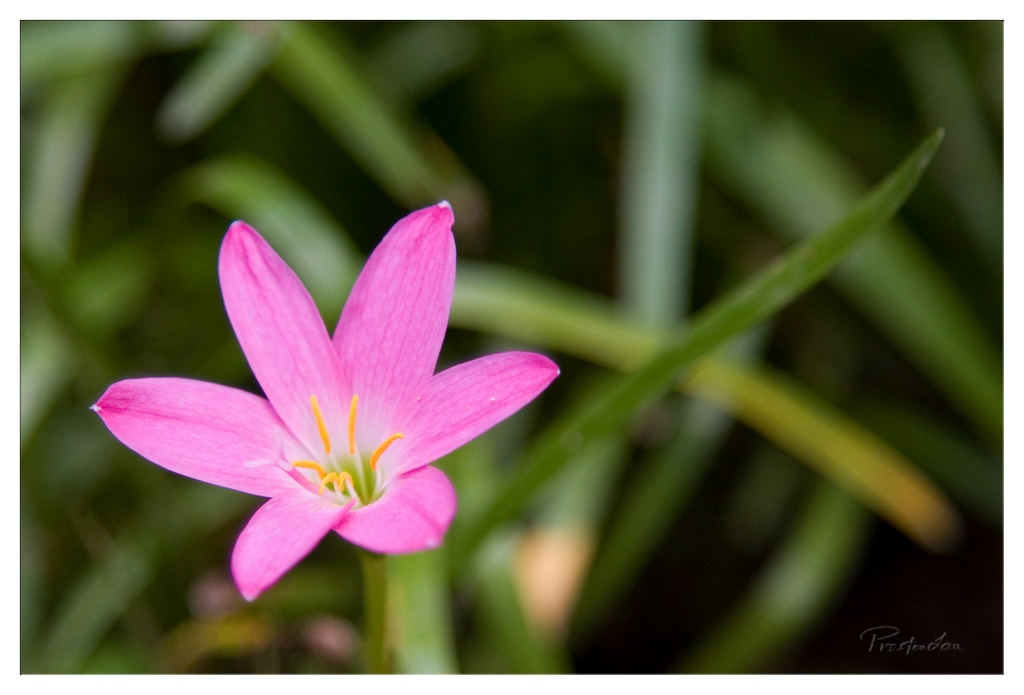

The Star of the Green Stage
Subject Rating: 9/10 (Would be 10/10 if it whispered its secrets)
This image presents a charming portrait of a single, resplendent pink flower, likely a Rain Lily, holding court against a backdrop of lush, blurred greenery. The bloom, with its symmetrical petals opening wide and its bright yellow stamens standing proud, is the undeniable star. It's a classic subject, rendered here with a soft touch that highlights its delicate structure and vibrant color. The mood is tranquil and focused, drawing the viewer's eye directly to the bloom and inviting contemplation of its simple beauty. It feels like a quiet moment captured, a pause in the garden's busy life just for this one perfect flower to shine.
Technically, the composition is strong, placing the flower slightly off-center to the left, which provides a pleasing asymmetry and guides the eye through the frame, rather than anchoring it statically in the middle. The depth of field is shallow, creating a beautiful, creamy bokeh that completely separates the subject from its environment, turning the background into abstract swathes of green. This decision effectively isolates the flower, making it pop with remarkable clarity. The lighting appears soft and diffused, preventing harsh shadows and allowing the subtle gradients of pink on the petals to be fully appreciated. It's a well-executed close-up that demonstrates control over focus and aperture to achieve a clean, subject-focused result, proving that sometimes, less is indeed more when it comes to background distractions.
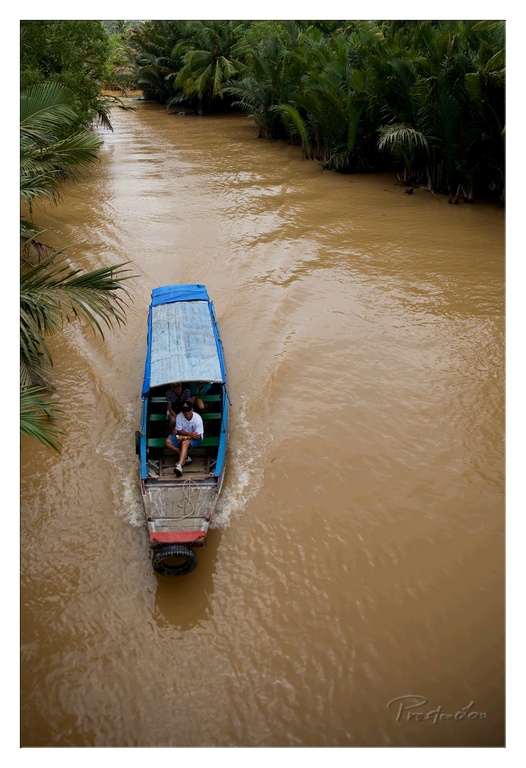

River Cruise in Chocolate Milk
Rating: 7/10
This elevated view captures a small, simple boat navigating a wide, muddy river, likely somewhere tropical given the dense, lush vegetation lining the banks. A couple of passengers are visible under the blue tarp roof, enjoying what appears to be a leisurely cruise down this decidedly non-crystal-clear waterway. The scene evokes a sense of quiet, everyday life in a region where rivers serve as vital transport links, offering a glimpse into the pace of life that's probably a world away from the hustle and bustle. The mood is calm and perhaps a touch exotic, highlighting the simple act of moving through a vibrant, albeit brown, natural environment.
From a photographic standpoint, the high angle provides a great overview, showing the boat in its environment and emphasizing the sheer scale of the river and the surrounding jungle. The composition places the boat off-center, giving the eye space to appreciate the water's texture and the ripples created by the boat's passage. Lighting is soft and even, suggesting an overcast day or perhaps early morning/late afternoon, preventing harsh shadows but also resulting in somewhat muted colors, dominated by the brown of the water and the deep greens of the foliage. The blue tarp roof is a welcome splash of color against the otherwise earthy palette. The inclusion of the tire fender at the front of the boat adds a touch of rustic charm and practical reality to this serene river journey. It's a nice capture of a moment, simple yet effective in conveying the scene.
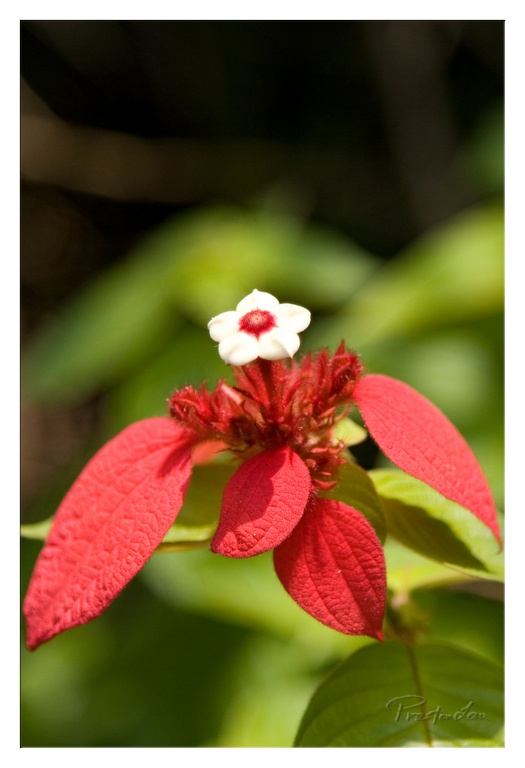

Floral Show-off
Rating: 8/10
This striking close-up captures a Mussaenda flower, or perhaps one of its flamboyant cousins, looking rather pleased with itself. What's happening here is a delightful botanical contradiction: a tiny, delicate white flower with a sassy red eye is perched atop a fuzzy red cluster, surrounded by huge, vibrant red bracts that look suspiciously like oversized, highly decorative leaves. It's like the plant decided its actual flowers weren't flashy enough and grew its own set of dramatic accessories. The mood is vibrant and almost theatrical, a nature-made spectacle demanding attention, proving that sometimes, less is definitely *not* more when it comes to floral fashion. It's certainly an attention-grabbing subject, strutting its stuff against a soft backdrop.
From a photographic perspective, this image is a solid piece of nature portraiture. The vertical composition suits the plant's upward growth, centering the main flower just right to draw the eye. The lighting, likely natural and coming from the side, does a fantastic job of highlighting the rich texture of the red bracts and the slightly fuzzy central structure, creating pleasing depth. The color palette is a winning combination – the intense reds pop beautifully against the soft, buttery green bokeh background, which effectively isolates the subject and prevents distractions. The depth of field is perfectly judged, placing the tiny white star and its immediate surroundings in sharp focus while blurring the rest into abstract color fields, a classic technique for macro or close-up work that really makes the subject shine. It's a great example of capturing a visually unique plant in a way that emphasizes its most compelling features.
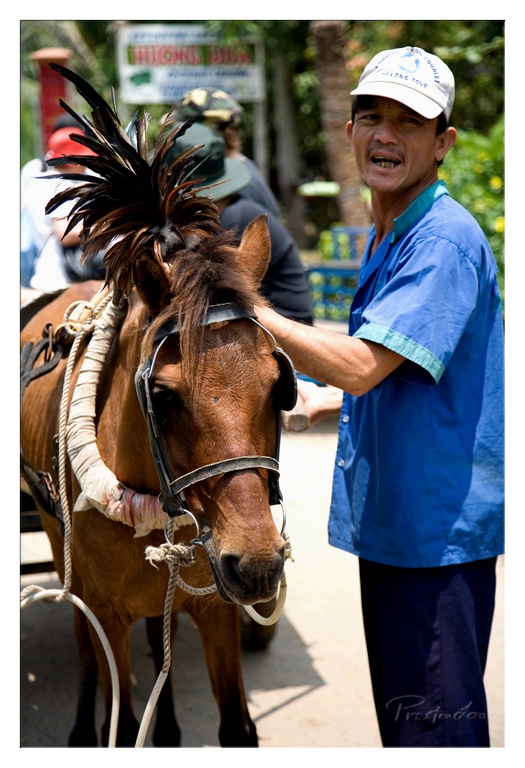

Horse Power Hug
Rating: 7/10
In this portrait-style shot, a man in a bright blue shirt and a white baseball cap is captured standing next to a brown horse, his right hand resting gently on the horse's forehead or mane area. The horse is adorned with a harness and bridle, featuring a rather impressive upright plume of dark feathers attached near its ears, giving it a slightly theatrical air. The man is looking directly at the camera with a wide-mouthed expression, perhaps mid-speech or reaction, revealing a smile with noticeable teeth. The setting appears to be outdoors during the day, possibly a tourist area given the blurred sign in the background that hints at "TOUR". Other blurred figures and greenery suggest a busy, lively environment behind the main subjects.
From a photographer's perspective, the composition utilizes the vertical format well, framing the two main subjects effectively, though the man's lower body is mostly cut off. The lighting is quite harsh, typical of direct sunlight, creating strong contrast and highlights which, while natural, aren't the most flattering and obscure some details in shadows. The bokeh is decent, helping to separate the subjects from the somewhat distracting background elements like the sign and other people. The color palette is dominated by the rich brown of the horse, the striking blue of the man's shirt, and the muted greens and browns of the background. While the interaction captured feels genuine, the focus appears slightly soft on the subjects themselves, perhaps landing more on the horse's mane than the eyes, which can dilute the impact of the portrait. The humorous element comes from the juxtaposition of the man's enthusiastic expression and the horse's placid, almost indifferent, demeanor, topped off by the horse's rather fancy feathered hairdo.
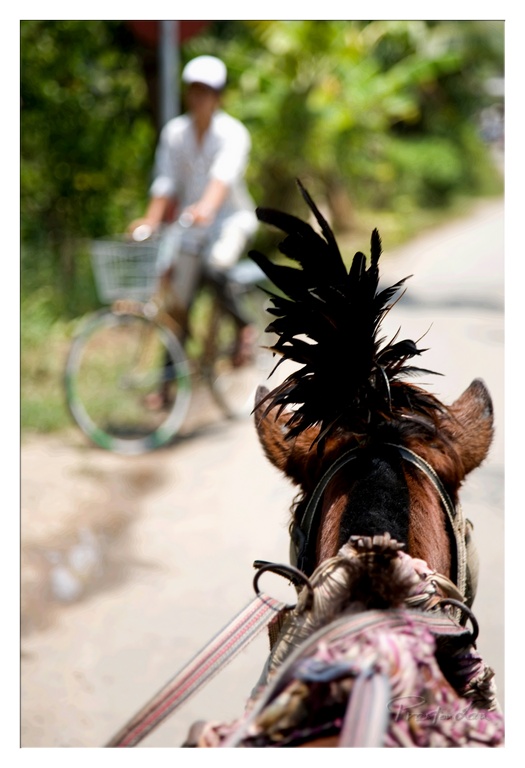

The Mohawk Mare and the Ghost Cyclist
7/10
From the perspective of someone enjoying a leisurely ride, we are treated to the magnificent posterior view of our main subject: a horse with a truly spectacular, gravity-defying black feathered mohawk (a solid 9/10 for equine style points alone). The horse's head dominates the foreground, offering an intimate glimpse of its brown coat, attentive ears, and the sturdy harness and saddle straps keeping it in check. The star of the show is undoubtedly the elaborate feather arrangement atop its mane, a bold fashion statement that adds immediate character and perhaps a touch of ceremonial flair. The shallow depth of field expertly isolates this stylish steed, drawing the eye directly to the intricate details of its headwear and the textures of its fur and tack.
Beyond the horse's fabulous coiffure, the background presents a hazy, dreamlike world where a cyclist glides along the path. Blurred into soft shapes by bokeh, the person on the bicycle (a ghostly 4/10 for visibility, bless their blurry heart) serves as a fleeting reminder of human presence and alternative modes of transport in this sun-drenched scene. The path is a warm, earthy tone, flanked by the vibrant, out-of-focus greens of foliage, suggesting a rural or semi-rural setting. The lighting is bright and natural, hinting at a sunny day, creating a warm overall tone that feels like a snapshot from a memorable journey. This composition is certainly unconventional, prioritizing the unique perspective and the striking visual element of the horse's decoration over traditional subject clarity, making for a quirky and memorable image.
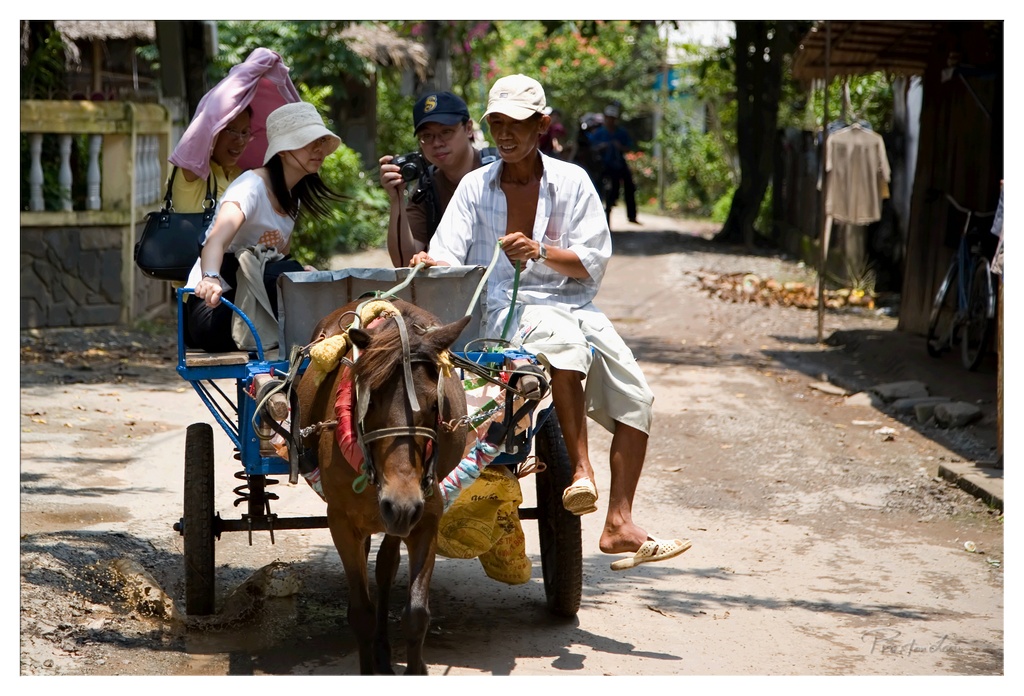

A sturdy horse powers a blue cart along a bumpy dirt road, splashing through puddles with impressive enthusiasm, or perhaps just the usual disregard for dryness. The cart carries a cast of characters: a stoic driver upfront, expertly handling the reins while looking ahead; a passenger shielded from the sun by pink fabric draped over her head, likely regretting not bringing a sturdier umbrella; and another passenger, looking intently at the scene through a camera lens, clearly prioritizing the shot over the spray. In the background, the road meanders past simple buildings and trees, suggesting a rural or semi-urban setting under a bright, probably sweltering sun. The air feels thick with heat and the potential for a truly epic puddle splash.
Subject Rating: 8/10 - A dynamic slice of life, full of movement and character, slightly marred by the challenging lighting conditions.
This shot captures a lively moment with a good sense of action, thanks to the well-timed splash in the foreground and the forward momentum of the cart. The composition places the horse and cart centrally, anchoring the scene while allowing the eye to follow the road back into the frame. The lighting is typical harsh midday sun, creating strong shadows and high contrast, which gives the image a certain raw authenticity but makes getting detail in both highlights and shadows tricky – a classic photographer's headache! While the light is tough, the photographer did well to expose for the scene. The warm colors of the dirt and horse contrast nicely with the bright blue of the cart and the green foliage. For a photographer, this highlights the challenge of shooting midday and the reward of capturing a dynamic moment, even if it means sacrificing some tonal range. The candid feel and the various reactions of the people make this image engaging, proving that sometimes the energy of the moment trumps perfect light.
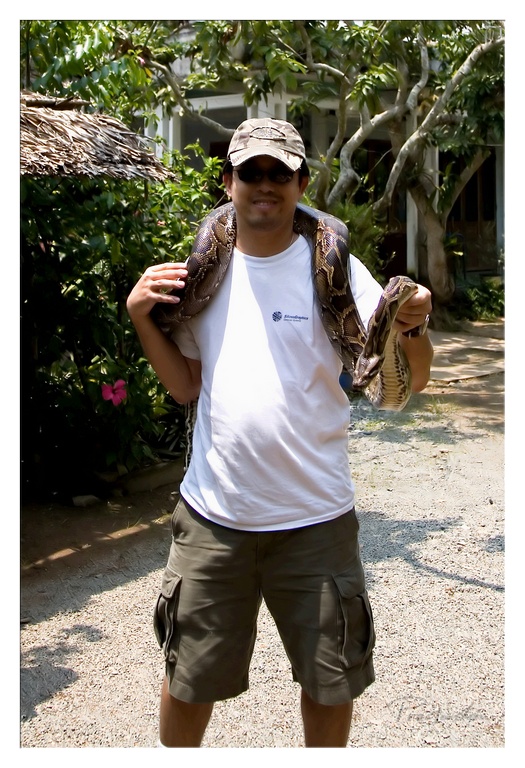

Title: My New Best Friend is Cold-Blooded (and Fashionable)
Rating: 7/10 (for the sheer chutzpah of the accessory choice)
Ah, the classic "tourist meets giant reptile" shot! Here we see a gentleman, rocking a camo cap and shades, proudly sporting a rather hefty snake around his neck like a scaly statement scarf. He's got a slight smile, perhaps contemplating if this is a viable alternative to a winter coat or just trying not to look terrified. He's even holding the snake's head with what looks like a mixture of confidence and mild apprehension – truly embracing the "hold my beer while I pet this python" energy. The mood is certainly adventurous and a tad edgy, set against a backdrop that screams warm vacation spot, complete with lush greenery, a rustic hut roof peaking in on the left, and tropical trees behind him.
From a photography perspective, the composition is a straightforward full-body portrait, letting the main subjects (man and snake) dominate the frame. The snake's coiled body forms a dynamic, curved line that adds visual interest and breaks up the verticality of the human subject. The lighting, typical of a bright sunny day, is quite harsh, creating strong shadows, especially on the ground and under the hat and sunglasses – it flattens some details on the man's face, making a softer light source or fill flash potentially beneficial. The colors are predominantly earthy and natural, fitting the outdoor environment, with the green foliage and brown snake/ground dominating, though a small splash of pink from a flower adds a little visual anchor on the left. The background, while busy with trees and structures, successfully sets the scene as a tropical or exotic location. It's a well-captured moment, leaning towards a posed snapshot style rather than a formal portrait, successfully documenting the subject's daring interaction with his serpentine companion.
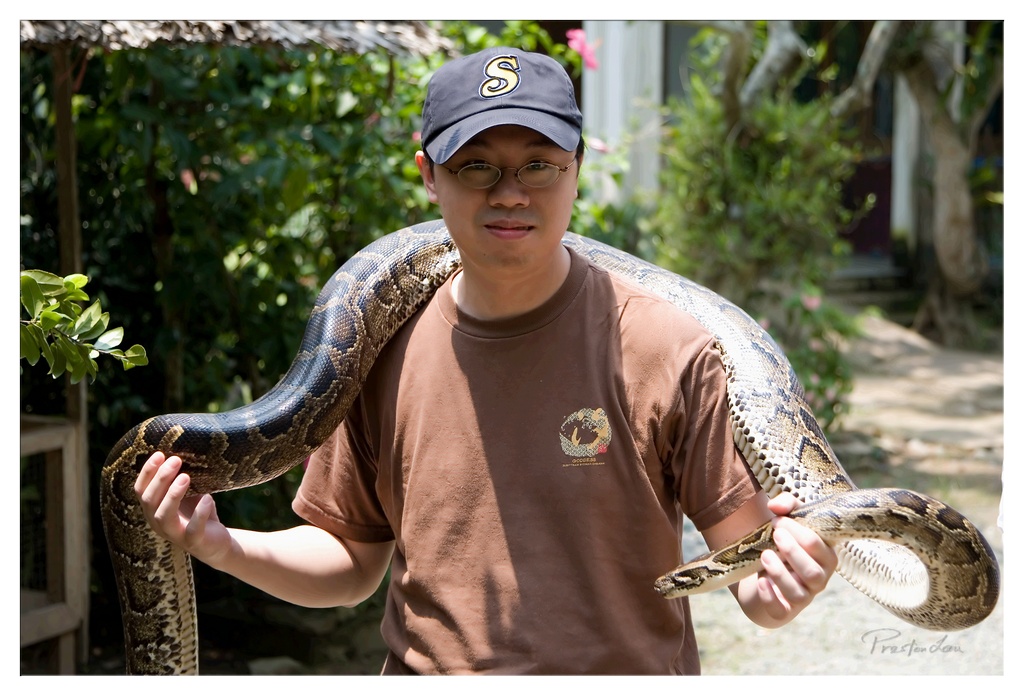

Man with Python Accessory
Rating: 8/10
This striking portrait features a man wearing glasses and a baseball cap with an 'S' logo, who appears to be trying his best to look nonchalant while draped with a truly enormous reticulated python. The impressive serpent coils around his neck and shoulders, its intricate diamond pattern contrasting with the man's simple brown t-shirt, which bears a small logo. The man holds the snake's body with both hands, looking straight at the camera with an expression that suggests either profound calm or mild resignation, creating a mood that is equal parts daring adventure and polite photo session awkwardness. The pairing of man and mega-snake certainly makes for a memorable subject combination.
Photographically, the composition is straightforward, placing the man and his scaly companion centrally in the frame, allowing the sweeping curve of the snake to dominate the visual flow. The natural lighting is soft and flattering, rendering the textures of both skin and scales effectively without harsh shadows, though a touch more light on the face could enhance the subject's presence. The background is a pleasingly blurred wash of green foliage and hints of structures, providing context without distracting from the main subjects. It's a well-executed example of capturing an unusual interaction, demonstrating a solid grasp of focus and exposure, even if the fashion choice is... unconventional.
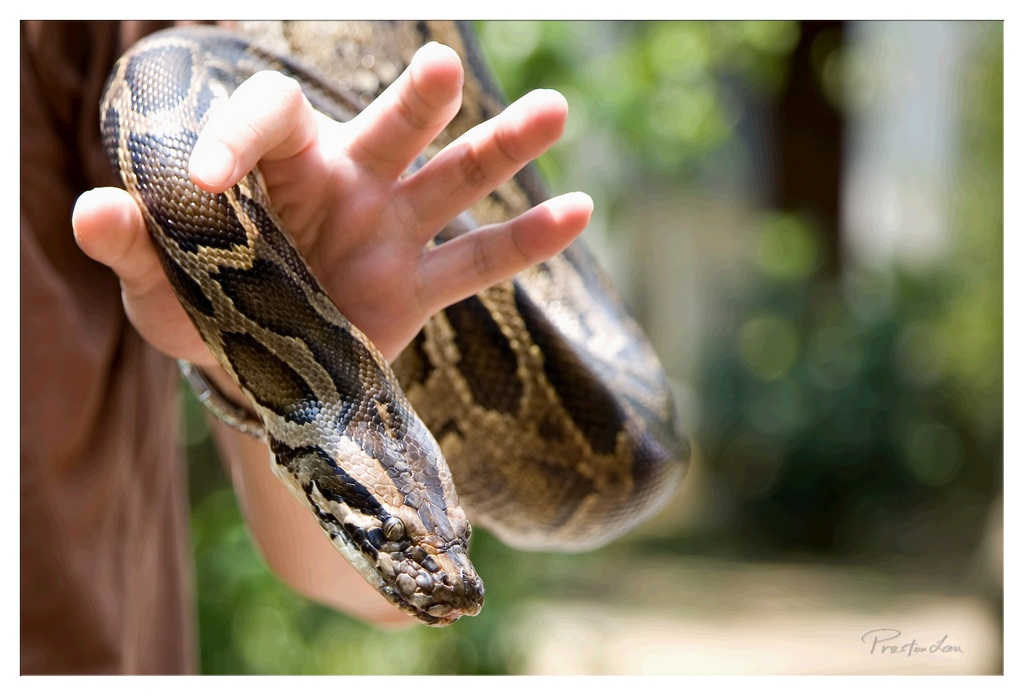

Handshake of Scales and Skin
Rating: 7/10
Well, hello there, Mr. Scales! This isn't your average handshake, is it? Here we have a brave (or perhaps just slightly masochistic) individual gripping a rather substantial snake, specifically its upper body and head. The snake, a beautiful pattern of browns and blacks, is being cradled by the hand, its head resting near the fingertips. It looks less like a friendly pat and more like a firm "Alright, let's not go anywhere, buddy." The mood is a curious mix of calm interaction with something often perceived as intimidating. The background is a pleasant, soft blur of green and earthy tones, typical of an outdoor setting, suggesting a park, zoo, or maybe someone's adventurous backyard.
From a photographer's perspective, the composition is strong, utilizing a close-up perspective that focuses entirely on the interaction between hand and serpent. The natural lighting is lovely, highlighting the intricate details and texture of the snake's scales – seriously, look at those patterns! The shallow depth of field creates a beautiful bokeh effect in the background, nicely isolating the subjects and making them pop. While the subject matter is undeniably engaging, perhaps a bit more of the hand or a slightly wider shot showing more of the person could add context, but the current framing certainly amps up the drama. It's a classic example of using focus to draw the viewer directly to the core action – the controlled connection between human and reptile. Now, if you'll excuse me, I think I'll stick to shaking hands with fellow humans, preferably ones without fangs.
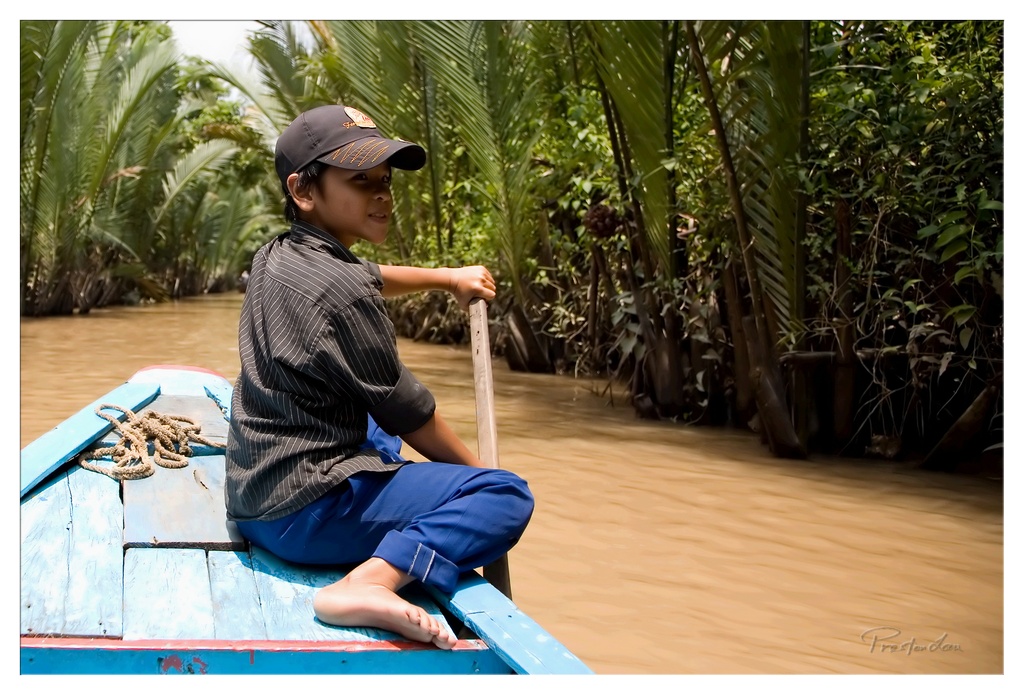

River Guide in Training
Subject Rating: 8/10
Ah, the life of a riverboat captain! Or perhaps just a young apprentice enjoying a day out on the muddy waters. Our young subject here looks rather contemplative, paddle in hand, pondering the mysteries of the Mekong Delta or wherever this lush waterway might be. He's perched on the beautifully weathered blue bow of his vessel, looking out at the next bend as if plotting a daring course... or perhaps just hoping for lunch. The rope coiled neatly beside him suggests this boat has seen a few mooring lines in its day. This candid shot captures a quiet moment of navigating through nature's green tunnel.
From a photographic standpoint, the composition here is quite effective. The boy is placed off-center, following the rule of thirds, and the lines of the boat's edge and the paddle cleverly act as leading lines, drawing your eye into the depth of the scene. The dense green vegetation on either side frames the brown, silty river nicely, creating a natural tunnel effect that emphasizes the journey. While the lighting is a bit flat, typical of midday sun diffused by overhead leaves, the colors are rich and earthy, with the bright blue boat providing a vibrant anchor point. It's a simple, authentic portrayal of life on the water, capturing both the person and their environment in a harmonious, albeit slightly muddy, embrace.
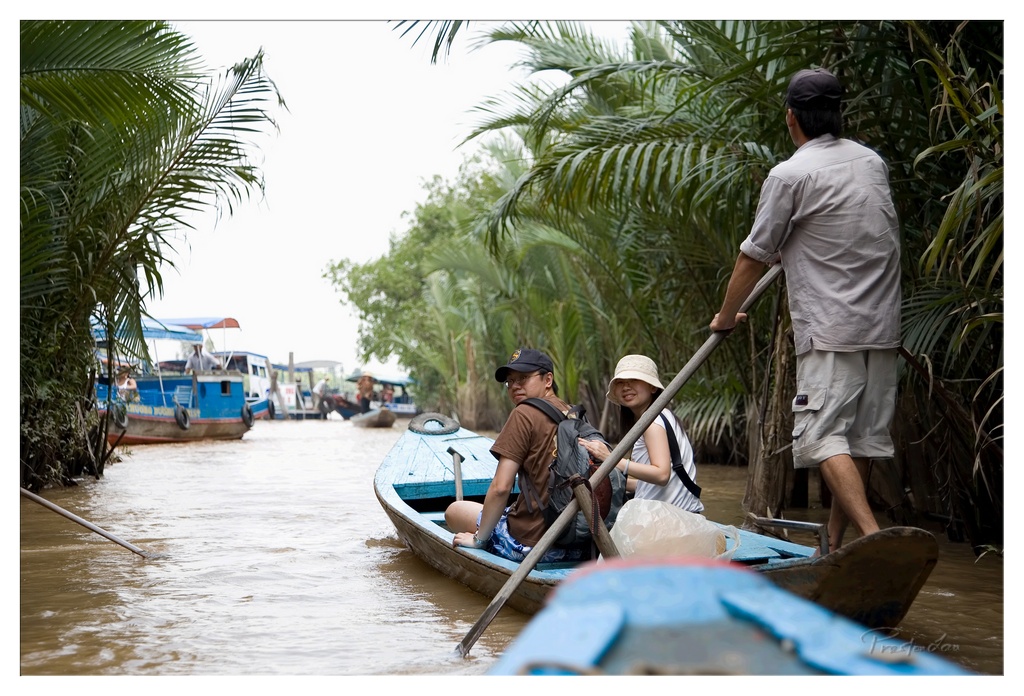

River Tour Serenade
Subject Rating: 8/10
Here we have a classic scene from a tropical river tour, capturing a moment of transport and gentle adventure. In the foreground, a sturdy wooden boat is navigated by a standing guide whose back is impressively square to the camera, intensely focused on the task at hand, rowing with a long oar that cuts across the frame like a disciplined diagonal line. Seated comfortably in the blue boat are two tourists, a man with a backpack and baseball cap looking directly at the camera with a curious expression, and a woman in a sunhat smiling serenely. Behind them, the waterway is lined with dense, lush green palm trees and other tropical foliage, creating a verdant tunnel effect. Further down the river, other similar boats are visible, hinting at the popular nature of this scenic route. It's a picture of calm movement, the kind of quiet passage through an exotic landscape that soothes the soul, despite the slightly murky water suggesting the river might be more functional than pristine.
From a photographer's perspective, this shot employs a neat trick by placing the viewer in the perspective of someone potentially in another boat close by, using the blurry blue boat in the bottom right as an intriguing, albeit slightly distracting, foreground element. The composition effectively uses the guide's posture and the oar to lead the eye towards the passengers and the waterway stretching into the background. The lighting, likely from an overcast sky, provides soft, diffused light, which is excellent for portraits and minimizes harsh shadows, though it does blow out the sky to a featureless white. The color palette is dominated by natural greens and browns, punctuated by the blue of the boat, creating a cohesive, earthy feel. While the focus on the tourists is sharp, giving them prominence, the overall scene feels a bit casual, perhaps captured quickly during the flow of the journey, giving it an authentic, slice-of-life vibe rather than a posed, epic landscape shot.
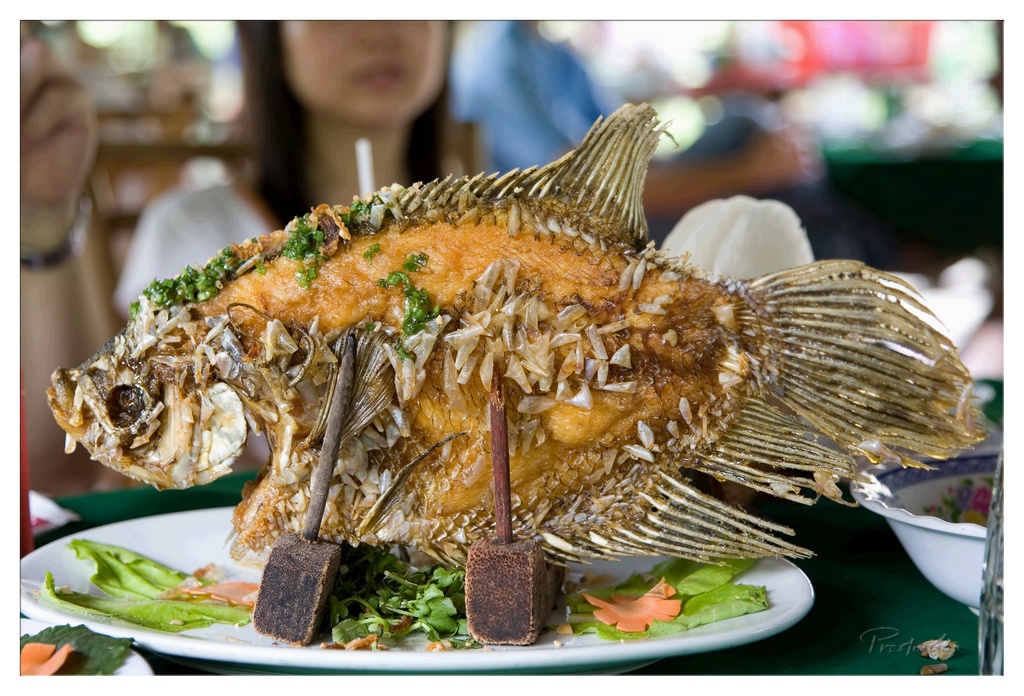

Deep-Fried Champion of the Table
Rating: 8/10 (For sheer, unadulterated fried glory)
Behold the undeniable star of the meal: a magnificent fried fish, propped up like a triumphant trophy on its white plate stage. This isn't just dinner; it's a performance art piece dedicated to the crispy scale. Adorned with chopped greens along its golden flank, and supported by what appear to be little edible (or perhaps just structural?) dark cubes, this fish is presented with dramatic flair. The mood is clearly focused on the main event, highlighting the exotic and perhaps slightly intimidating deliciousness that is about to be consumed. Fresh greens and shredded carrots provide a colorful base, while a bright white blob in the background (rice? another garnish?) adds to the visual texture of the spread.
From a photographic standpoint, the composition is classic food porn: the main subject is front and center, sharp and detailed, while the background melts away into a pleasing bokeh of restaurant chaos. The shallow depth of field effectively isolates the fish, letting you admire every crispy scale and flake of fried flesh. The lighting appears natural, highlighting the texture of the fish beautifully, although it does create some bright reflections on the tail. The color palette is dominated by the warm, inviting browns and oranges of the fish contrasting with the vibrant greens of the garnish and the table. The blurred background includes glimpses of people (one holding a straw, seemingly mid-conversation) and various restaurant elements, adding context without stealing the show. It’s a shot that makes you want to reach out and tap one of those gravity-defying scales – a bold culinary and photographic statement!
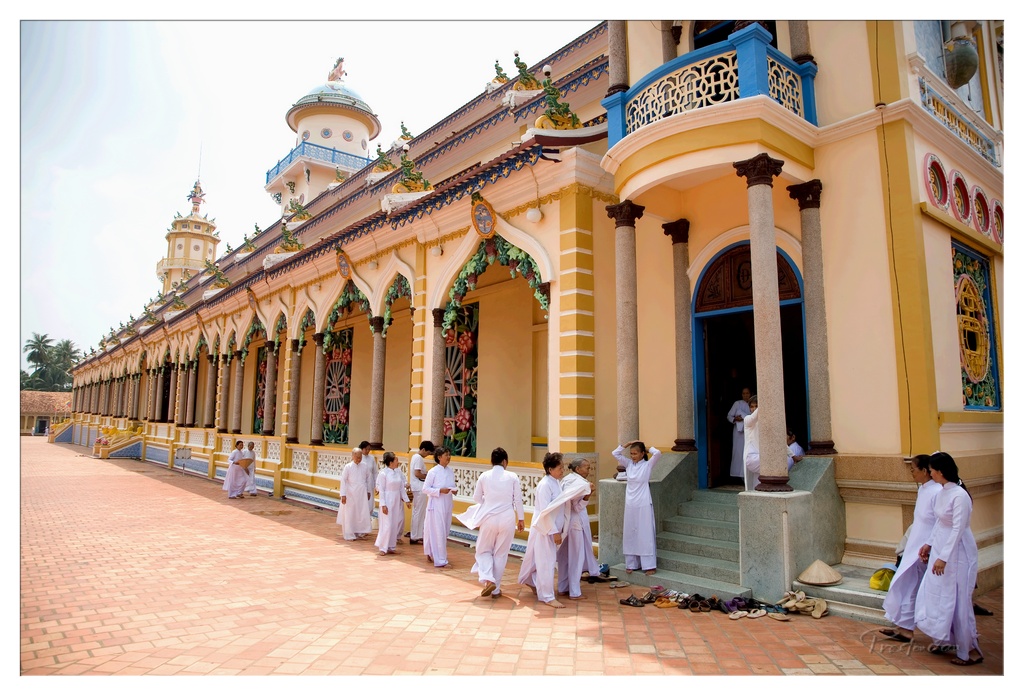

Journey in White
Subject Rating: 9/10
This expansive shot captures the striking, multi-domed architecture of a temple or pagoda, rendered in warm yellow and cream tones with vibrant blue and red accents. The building's long, colonnaded facade stretches into the distance, its ornate details like arched windows, intricate roof decoration, and distinct towers standing out against a bright sky. In the foreground, a group of people dressed uniformly in crisp white robes walk along a wide, terracotta-tiled courtyard towards the building entrance, adding a human element and sense of gentle movement to the scene. The mood is one of quiet reverence and the tranquility of a spiritual gathering under the bright tropical sun.
From a photographic perspective, the composition effectively uses the building's length and the leading lines of the courtyard tiles to draw the eye into the scene, creating a strong sense of depth. The bright sunlight, while enhancing the vibrant colors of the architecture, also creates strong shadows and blows out the detail in the sky, a classic challenge in harsh mid-day light. The uniform white attire of the people provides a clean contrast against the warm-toned building and ground, though it also makes exposing for their detail tricky under the bright conditions. The pile of shoes by the entrance is a charmingly relatable detail, reminding us that even in spiritual places, practicalities (and dress codes, apparently) apply. Overall, it's a well-captured moment showcasing a beautiful and culturally rich location, perhaps just a shade away from perfection with a softer lighting scenario.
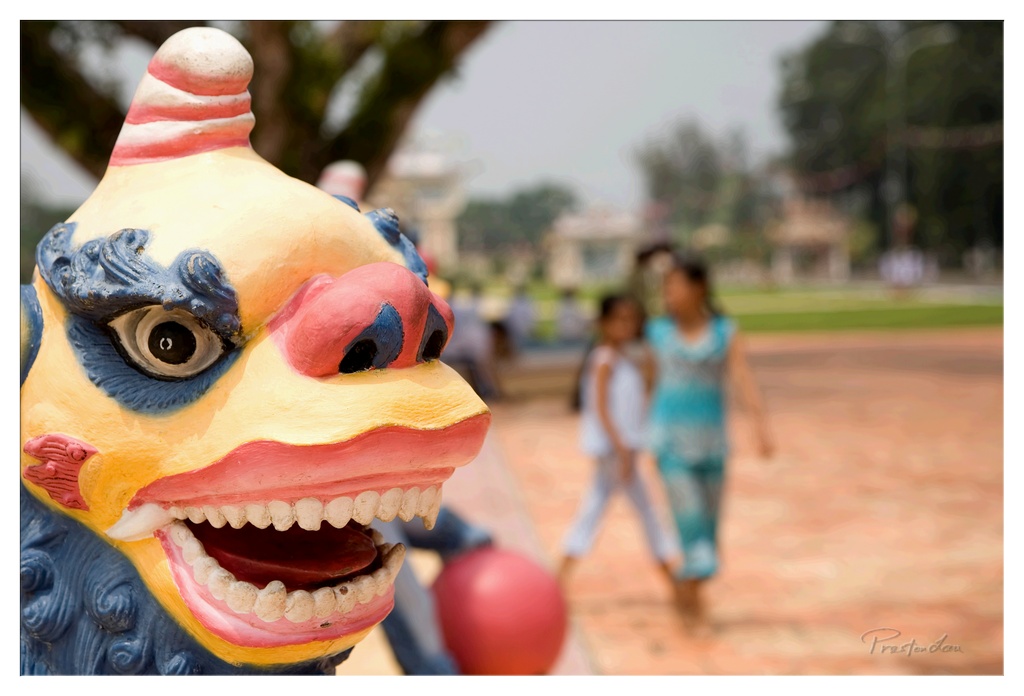

Grinning Guardian
Subject Rating: 8/10
Dominating the foreground with a vibrant, slightly unnerving intensity is a statue of what appears to be a guardian lion or dragon, painted in bold strokes of yellow, blue, pink, and white. Its wide-open mouth reveals a fearsome array of teeth and a glimpse of something red within, while its large eye stares directly ahead. The statue is the undisputed star here, sharply focused and commanding attention. Behind it, the world dissolves into a soft, painterly blur. Two figures, likely people, walk away from the camera in the mid-ground, their forms indistinct shapes of white and blue, accompanied by a mysterious large red sphere resting on the ground. The atmosphere is one of bright, sunny juxtaposition – a highly detailed, almost aggressive static figure contrasting with the fleeting, hazy movement of life and objects in the background.
From a technical standpoint, this image excels in its use of shallow depth of field, employing a wide aperture to create a strong bokeh effect that beautifully isolates the main subject. The focus is critically sharp on the statue's face, highlighting its intricate details and textures. The lighting is bright and likely overhead sunlight, which brings out the saturated colors of the statue, making them pop vividly. Compositionally, the statue fills the left side of the frame, its gaze directing the viewer's eye towards the blurred scene unfolding on the right. The choice to render the background so completely out of focus effectively simplifies the scene, removing distracting elements and emphasizing the quirky, colorful subject in the foreground. It’s a style that sacrifices environmental context for a striking portrait of an inanimate object, leaving the viewer to ponder the story behind the blurry figures and the enigma of the red ball. Perhaps the photographer was just *really* into that statue's dental work.
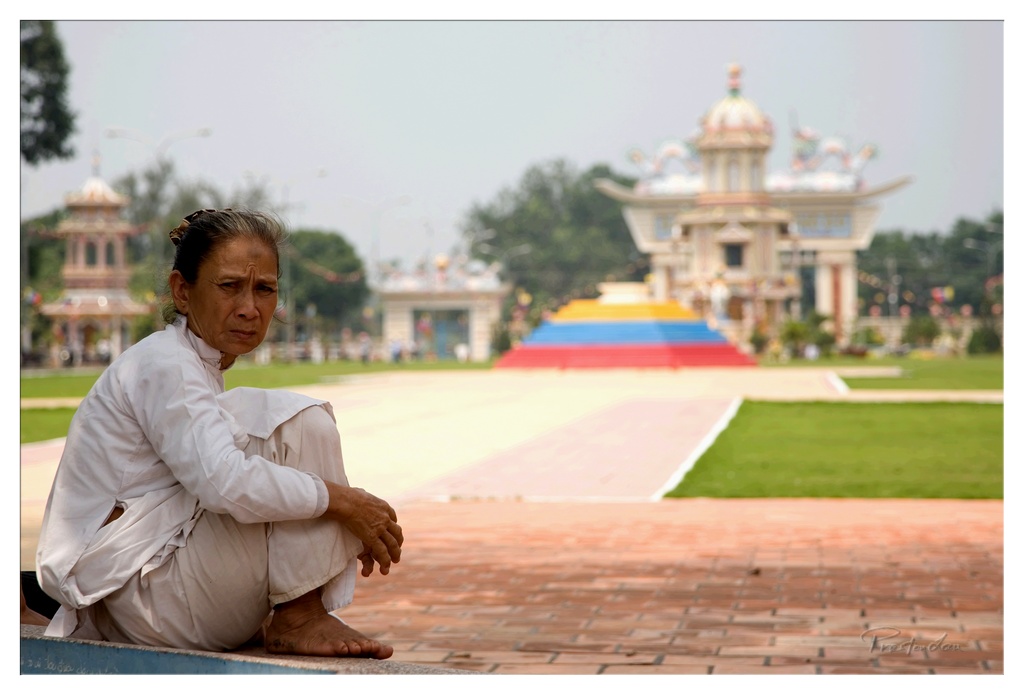

Contemplation by the Temple
Rating: Subject 9/10
Our subject here, an elderly woman seated with a pensive gaze directed right at the camera, earns a solid 9/10 for her sheer presence and the compelling narrative etched into her face. Clad in simple white attire, perhaps traditional or religious, she sits barefoot on a low wall or step, her posture suggesting a moment of rest or deep thought. Her expression is complex – serious, weary, maybe a touch of apprehension, drawing the viewer in and making you wonder what she's contemplating. The tight crop and shallow depth of field ensure she is the undeniable star of this shot, her face rendered with striking clarity against the softly blurred background, making every wrinkle a roadmap of a life lived.
Behind our seated figure unfolds a scene of rather grand architecture. A prominent, ornate temple or pagoda dominates the background, its distinctive roofline reaching towards the overcast sky. In the middle ground, a stepped structure in bright primary colors (blue, yellow, red) adds a splash of vibrancy, contrasting with the more muted tones of the scene. A wide, paved path leads the eye back towards these buildings, creating a sense of depth, while a strip of vibrant green grass on the right provides a natural counterpoint to the brickwork in the foreground. The photographer wisely used a low angle and placed the subject off-center, roughly adhering to the rule of thirds, balancing the human element against the architectural backdrop. The soft, diffused light on this cloudy day is quite flattering, preventing harsh shadows and lending a gentle, contemplative atmosphere to the entire scene. It feels like a quiet moment captured amidst a potentially busy spiritual site, focusing intensely on one individual's experience within that space.
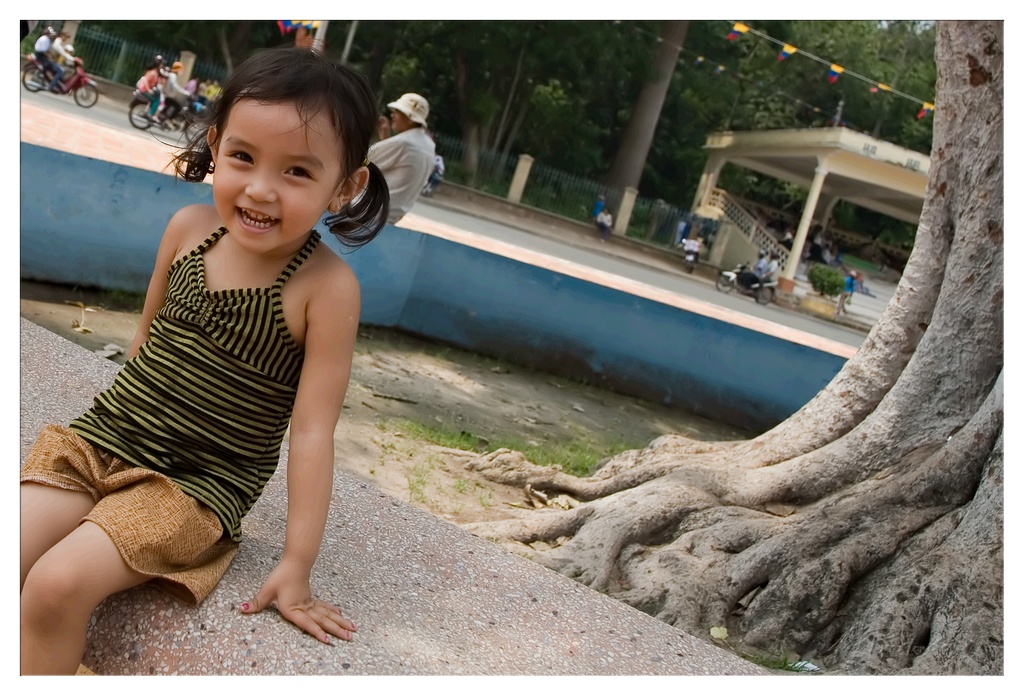

Sunny Smile and Rooted Background
Subject Rating: 9/10 - This young lady is a natural model! Her bright smile and engaging eyes absolutely make this photo. She looks energetic and happy, perfectly embodying a playful spirit. Sitting on a concrete ledge, she's clearly the intended star of the show, looking directly at the camera with a wide, toothy grin. Her striped tank top and patterned shorts are simple but suit the casual outdoor setting.
The scene unfolds behind her with a vibrant slice of daily life. A blue wall separates the foreground from a busy street with motorcycles whizzing by and pedestrians in the distance. On the right, a massive tree trunk with impressive, gnarly roots anchors the scene, providing a stark textural contrast to the smooth ledge and the girl's skin. Further back, a pavilion or bandstand adds architectural interest, topped by colorful flags strung overhead, suggesting a festive or public space. The overall mood is lively and cheerful, reflecting the subject's expression within a bustling environment.
From a photographer's perspective, the composition is a bold choice. The off-center placement of the subject works well, but the tilted angle (Dutch tilt) feels a little gratuitous here – does it add dynamism, or just make the viewer slightly seasick? The enormous tree roots on the right are fantastic in their detail and texture, but they seriously compete for attention with our delightful subject, perhaps even stealing a bit of her thunder. The lighting is bright and sunny, giving good exposure to the girl, though the background seems slightly overexposed, which can happen on bright days when you expose for the subject's face. While the busy background adds context and atmosphere, it also introduces visual clutter. Less distracting elements would have allowed the subject's captivating expression to shine even brighter. It's a shot bursting with life and character, even if the roots are giving our lead a run for her money.
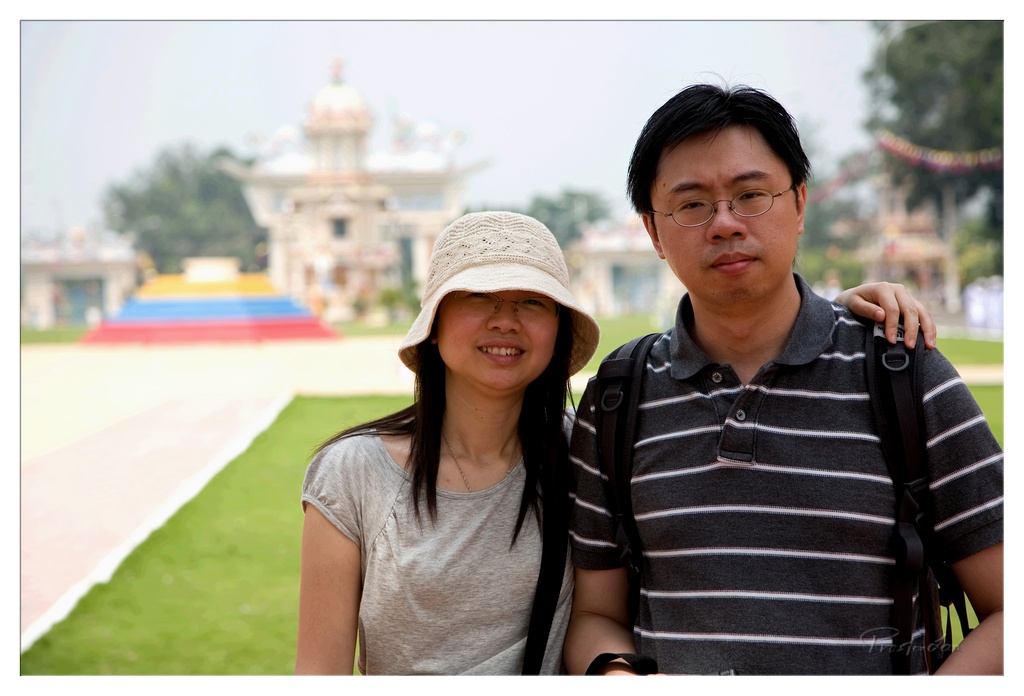

Travel Companions and Colorful Steps
Rating: 8/10
Here we have a charming couple, likely mid-adventure, pausing for a classic travel snapshot. The woman, sporting a fetching sun hat that casts a mysterious shadow over her eyes, offers a bright smile, while her partner gives the camera a more thoughtful, perhaps slightly weary, look – a familiar dynamic for anyone who's ever navigated tourist crowds together. He's rocking a striped polo and backpack combo, ready for anything from a gentle stroll to a sudden need for emergency snacks. His hand casually rests on her shoulder, a gesture that says either "together we stand" or "I'm using you as a convenient armrest after climbing those steps." The overall mood is relaxed and friendly, capturing a simple moment of connection against a rather vibrant backdrop.
From a technical standpoint, this image employs a pleasant shallow depth of field, skillfully blurring the background into a wash of color and form, making the subjects truly stand out. The lighting, likely from an overcast sky, is soft and diffused – a photographer's dream for portraits as it avoids harsh shadows and unflattering highlights, though the hat does its job a little *too* well in shading the woman's eyes. Compositionally, they're nicely framed, filling the space without feeling cramped. The background provides interesting context with the distant architectural structure and the eye-catching red, yellow, and blue steps, looking like a giant, slightly faded, primary-colored cake. It's a solid, well-executed portrait capturing the subjects clearly while hinting at the interesting location they're exploring.
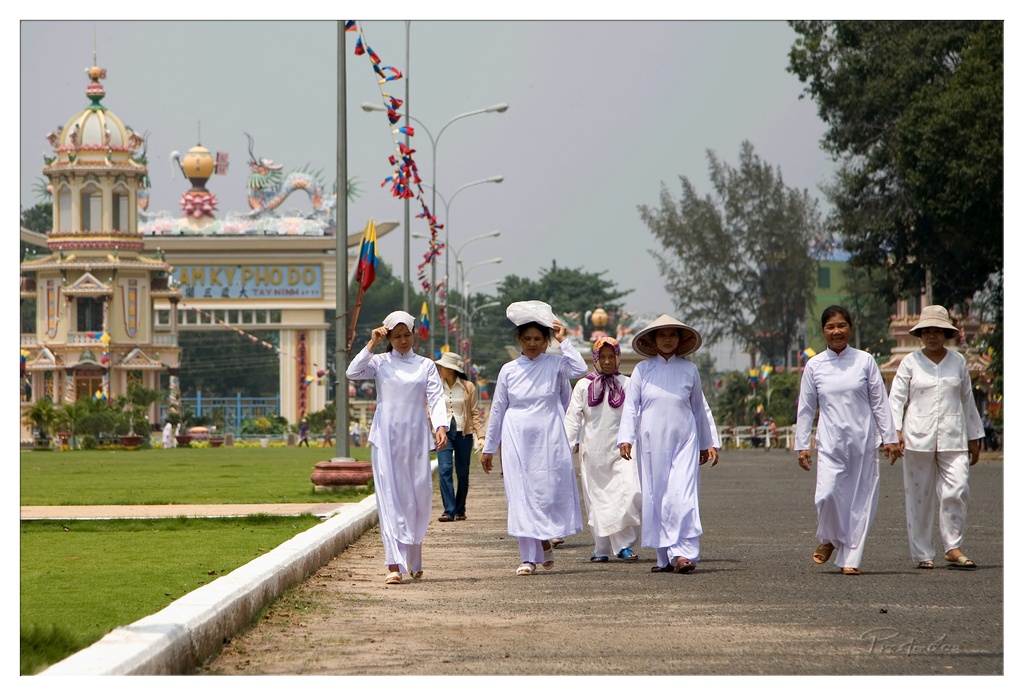

Walking Towards the Divine
Rating: 8/10
In this captivating scene, a group of individuals, predominantly women clad in flowing white garments, embark on a purposeful journey along a sun-drenched path. The mood feels serene and potentially spiritual, as they walk towards a magnificent, ornate building in the background, which appears to be part of a temple or religious complex, complete with a large, colorful archway featuring intricate details and a prominent dragon motif. The path is lined by well-maintained green grass, streetlights adorned with vibrant flags, and distant trees, all set against a slightly hazy sky typical of a warm day. The subjects are the clear focus, their simple yet striking attire standing out against the more elaborate backdrop, suggesting a pilgrimage or significant gathering at this impressive architectural site.
From a photographic perspective, the composition effectively uses the converging lines of the path to draw the viewer into the scene and towards the subjects and the impressive background structure. The bright, potentially harsh midday lighting creates strong highlights on the white clothes, emphasizing their purity, though it also contributes to some heat haze visible in the distance – a testament to the environmental conditions of the shoot. The contrast between the simple white subjects and the richly decorated background adds visual interest. While the horizon might be slightly off-kilter, it doesn't significantly detract from the overall impact. It's a well-captured moment that combines human interest with striking cultural and architectural elements, effectively conveying the essence of a journey towards a significant destination. One might humorously note that this group clearly understood the assignment regarding the 'white party' dress code for heavenly destinations.
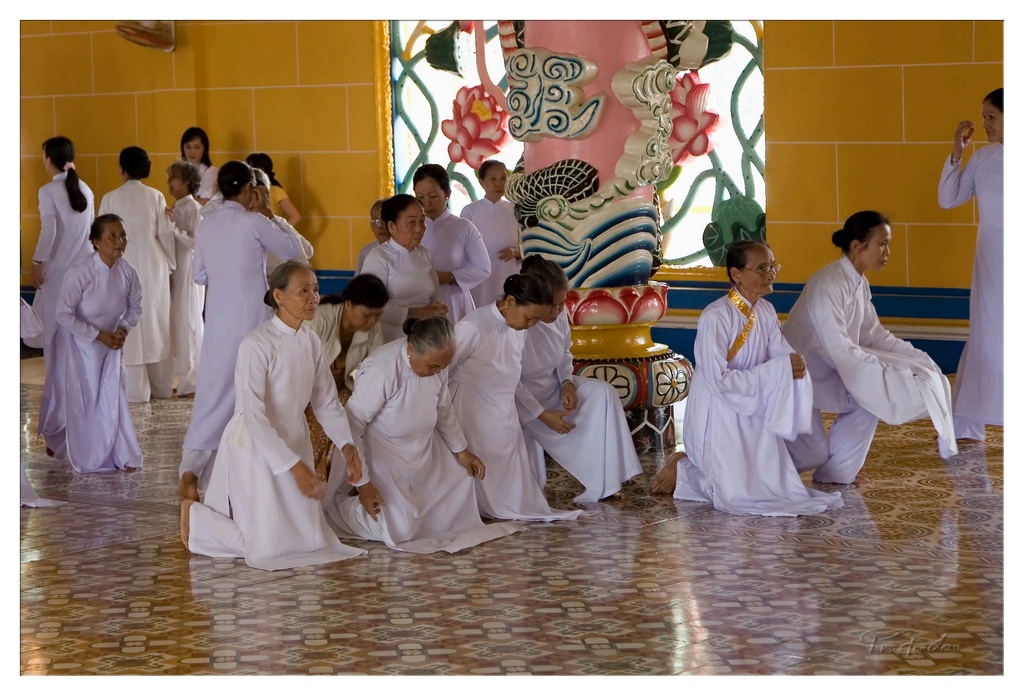

Kneeling Devotion Amidst Temple Colors
Subject Rating: 7/10 (Culturally rich, capturing a moment of spiritual practice, but the crowded composition and busy background make finding a single focal point a challenge)
This image transports us into what appears to be a serene moment within a Buddhist temple or pagoda, where a group of women, predominantly older and dressed in traditional white garments, are engaged in prayer or a religious ceremony. The mood is distinctly peaceful and devotional, with many figures shown in a posture of kneeling respect. In the foreground, several women are either fully kneeling or preparing to do so, their white robes cascading around them. The background reveals more figures, some standing, as well as the vibrant interior architecture – a striking pink and blue decorative column adorned with lotus motifs and stylized waves, set against a bright yellow wall and a large window with intricate, colorful patterns that allow light to filter in. The patterned, reflective tile floor adds another layer of visual texture and contributes to the bright, airy feel of the space.
From a photographic perspective, the composition captures a candid, documentary feel, placing the group of kneeling figures front and center. While the diagonal line created by these figures provides a nice lead into the scene, the overall composition feels a touch busy, with the prominent decorative column competing for attention with the human subjects. The lighting appears to be natural and soft, likely coming from the large window, providing relatively even illumination, which is crucial when photographing bright white subjects. Managing exposure with such dominant whites can be tricky, but the photographer seems to have handled it reasonably well, avoiding significant blowouts. The color palette is a fascinating mix of the stark white robes, the warm yellow wall, the cool blues and pinks of the column, and the earthy tones of the floor tiles. It's a vibrant setting for a moment of quiet reflection, making for an image that is both culturally informative and visually engaging, even if the photographer had to navigate the tricky task of capturing individual devotion within a bustling group scene.
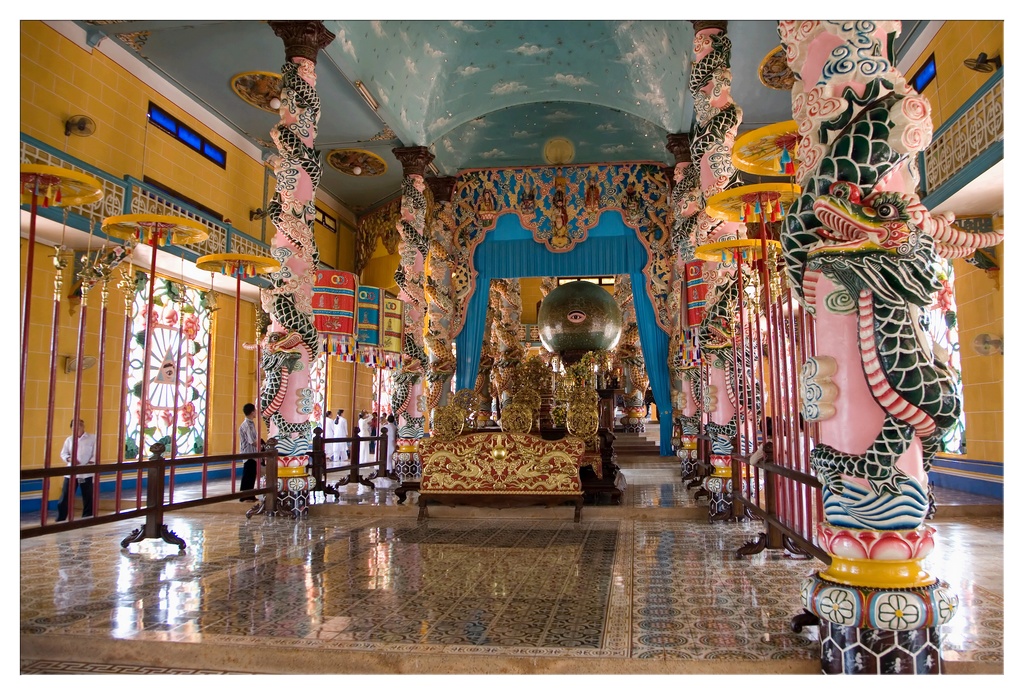

Temple of Technicolor Dreams
Subject Rating: 8/10
Step right up to the visual feast that is this temple interior! Our subject is the gloriously over-the-top sanctuary of what appears to be a Cao Dai temple, an absolute riot of color and intricate detail. What's happening? Well, primarily, the architecture is just *happening* all over the place, demanding your attention with its maximalist design. People are milling in the background, perhaps recovering from sensory overload, or just patiently waiting for the dragons to stop spiraling up the pink pillars. The mood is undeniably vibrant and spiritual, but also carries a touch of delightful absurdity thanks to the sheer density and daring combination of decorative elements. Pertinent objects include those frankly fabulous candy-pink pillars wrapped in green and black dragons, a gleaming central altar crowned by a massive, slightly unsettling sphere bearing the Eye of Providence, and golden decorative elements that seem to be screaming "Look at me!" from every surface. The background features bright yellow walls punctuated by large windows showcasing stained glass and more distant human figures.
From a photographic standpoint, this image is a brave attempt to capture a truly overwhelming space. The composition tries for symmetry, anchoring on the central altar, but the low red barrier slicing across the lower foreground is a bit of a trip hazard for the eye. The natural light from the windows illuminates the left side nicely, but the highly polished, patterned tile floor is reflecting so much light it's practically competing with the main subject – talk about reflections gone wild! The color grading is a character in itself; it's intensely saturated, pushing the already bold yellow, pink, blue, and gold into eye-watering territory. While it perfectly conveys the temple's flamboyant style, it leaves little room for subtlety. Capturing such a busy and detailed scene is a challenge, and while the image successfully conveys the *feel* of the place – a whirlwind of spiritual energy and questionable interior design choices – it could benefit from a slightly less cluttered foreground and perhaps a moment when the floor wasn't trying to steal the spotlight with its disco-ball tendencies. Still, it’s a captivating glimpse into a truly unique place.
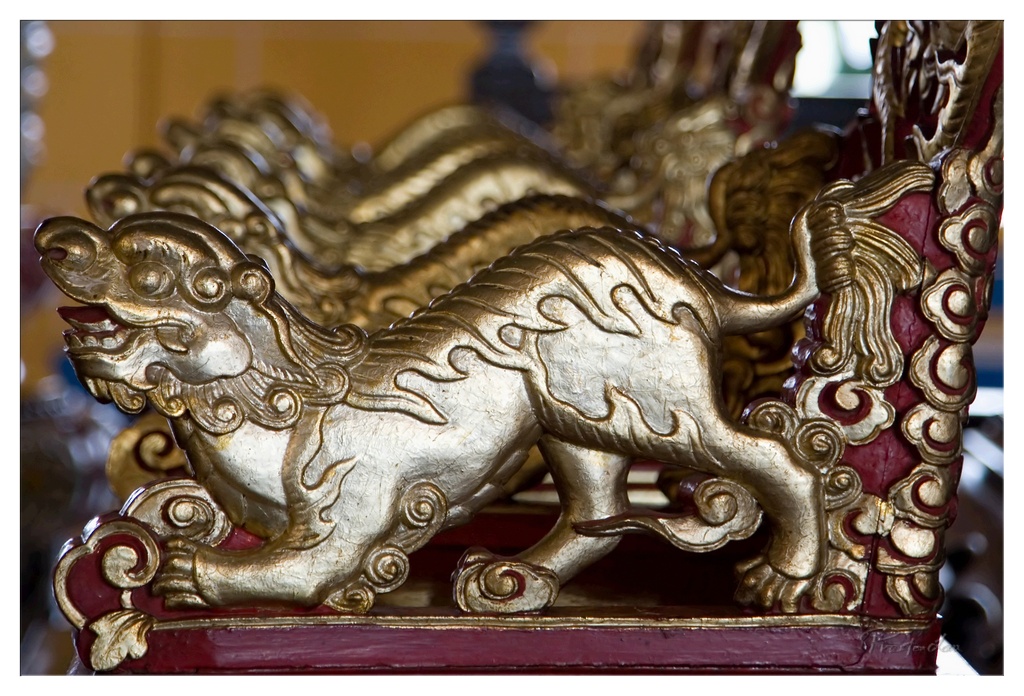

Title: The Golden Sentinel Line-Up
Rating: Subject - 8/10
This image captures a magnificent close-up of a gilded statue, likely a guardian creature such as a Pixiu or a stylized lion, rendered in opulent gold leaf and set upon a vibrant red and gold base. The creature is posed dynamically, as if mid-stride, with intricate swirling patterns adorning its body and mane, and sharp teeth visible in its open mouth. Behind this central figure, a line of similar golden creatures recedes into a warm, blurred background, creating a sense of depth and scale, hinting at a larger decorative installation or a row of identical sentinels guarding a space. The overall mood is one of rich tradition, skilled craftsmanship, and slightly fierce regality, making for a striking visual subject.
From a photographic standpoint, the composition expertly utilizes a shallow depth of field to isolate the primary subject, allowing the viewer to appreciate the fine details and texture of the gold leaf, which looks like it's been applied with painstaking care (or maybe just really good glue). The lighting does a solid job of highlighting the metallic sheen, though the shadows could perhaps be lifted slightly to reveal more detail in the darker areas, giving it a touch more polish – or embrace the drama, who am I to judge its shadowy secrets? The contrast between the shimmering gold and the deep, textured red is visually impactful, drawing the eye and adding to the sense of luxury. The repetition of the forms behind, even out of focus, adds a nice rhythmic element to the frame, suggesting a grander context beyond this single glittering guardian, standing stoicly, perhaps waiting for someone to notice its good side.
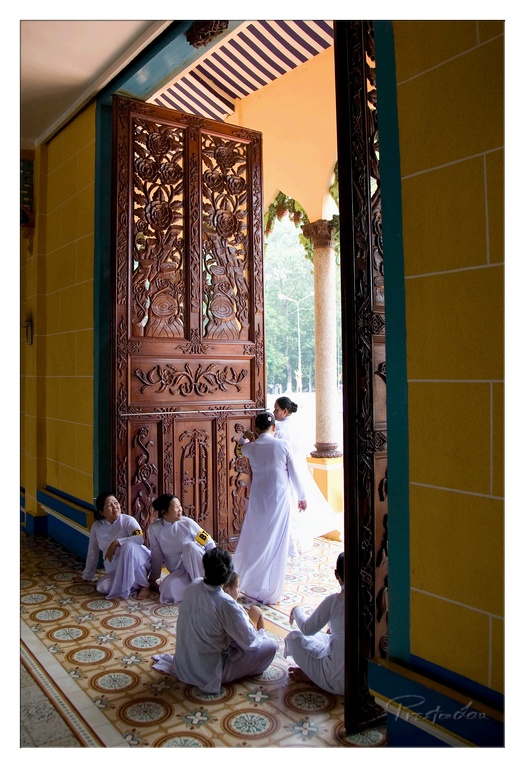

The Waiting by the Grand Door: 8/10
This image captures a serene moment of repose or waiting near a truly magnificent, heavily carved wooden door. A group of individuals, all clad in simple white robes, are gathered in the foreground. Some are seated peacefully on the ornately patterned tiled floor, while one figure stands near the open doorway, perhaps adjusting her attire or assisting another. The scene feels quiet and contemplative, suggesting a pause before or after an event, possibly within a temple or spiritual building. The subject matter is a compelling blend of human presence and impressive architecture, highlighting the beauty of both the people and their surroundings. The stillness of the figures contrasts nicely with the dynamic detail of the carved wood and patterned floor tiles.
From a photographic perspective, the composition is quite effective, using the imposing vertical lines of the door and the dark frame on the right to create a strong sense of depth and structure. The placement of the people in the lower half of the frame anchors the scene and provides a human scale against the grandeur of the entrance. The natural light streaming in from the exterior beautifully illuminates the subjects and brings out the rich texture and detail of the wooden carvings and the tiled floor. The color palette is vibrant yet balanced, with the bold yellow walls and blue trim providing a striking backdrop for the more subdued whites and browns. It's a great capture of a seemingly everyday moment made extraordinary by the stunning setting; makes you wonder what epic event warrants such a door, or if it's just for dramatic exits after a long day of... spiritual activities.
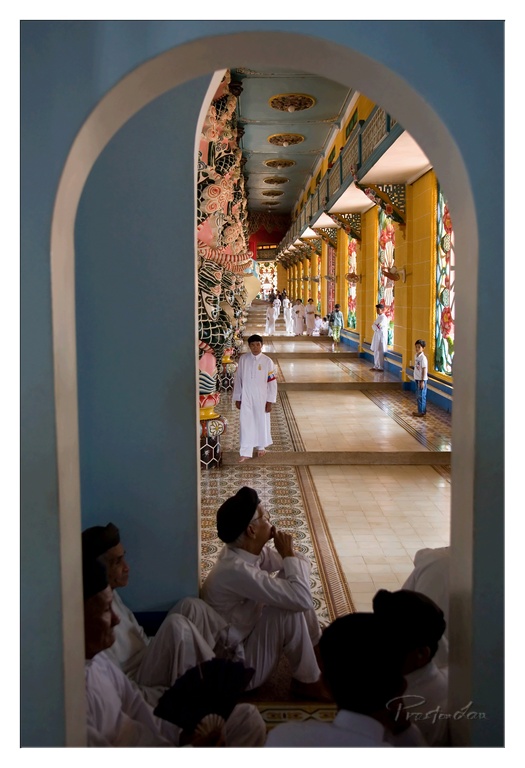

Framed Faith
Rating: 8/10
Peeking through a cool blue archway, we're treated to a vibrant slice of life inside what appears to be a bustling temple or religious hall. The subject here is less a single entity and more the entire scene: a fascinating juxtaposition of quiet observation in the foreground against a dynamic procession further down the ridiculously colorful and ornate hallway. People dressed in crisp white robes are either walking purposefully or standing, while in the foreground, several individuals sit relaxed, creating layers of human activity within the frame. The mood feels serene yet expectant, capturing a moment of gathering or transition.
From a photographic standpoint, the composition is the clear winner. Using the foreground arch as a natural frame dramatically increases the sense of depth and adds a compelling element of voyeurism, as if we're being given a private view. The long, straight hallway provides powerful leading lines that draw the eye deep into the background, where more white-robed figures are visible. The lighting, likely natural light streaming in from the side, casts subtle shadows and highlights the intense colors of the walls and ceiling decorations – seriously, it's like a paint factory exploded, in the best possible way. The contrast between the darker, cool blue foreground and the brightly lit, warm-toned hallway is visually striking and directs attention right where the photographer wants it. It's a great example of capturing a cultural scene with strong architectural and human interest, making the best use of available elements to create a visually rich narrative.
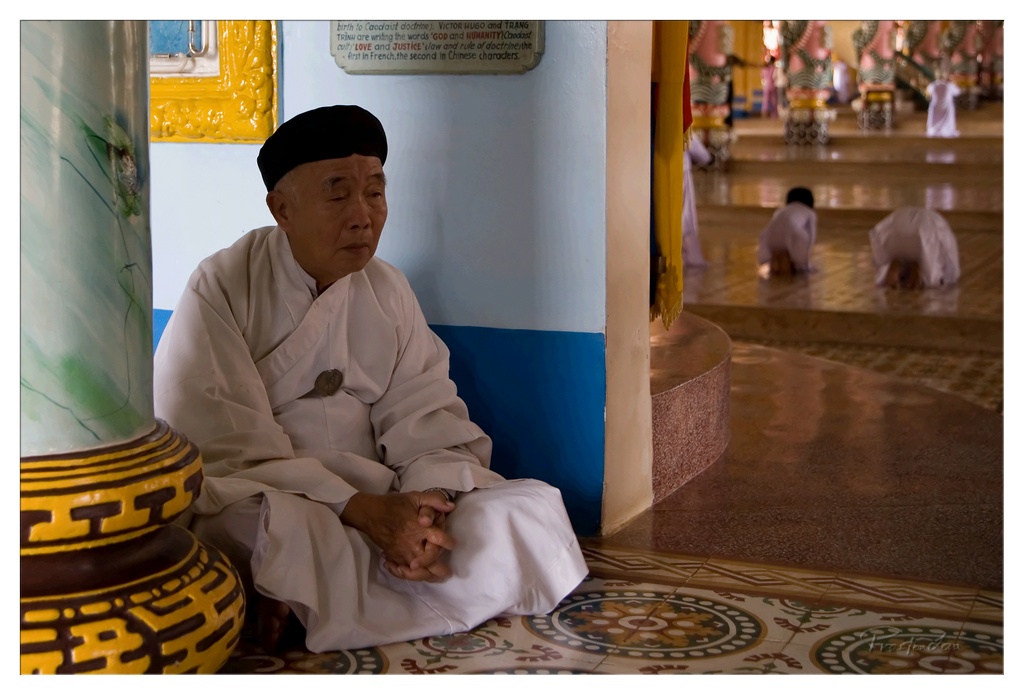

A Moment of Quiet Devotion
Subject Rating: 8/10
In this peaceful temple interior, an elderly man draped in flowing white robes and a black cap sits in deep contemplation, his hands clasped and eyes closed. He's settled on the patterned floor tiles near a large decorative pillar, seemingly detached from the activity happening further up the steps in the background, where other figures, including children, are visible kneeling and engaged in prayer. The scene exudes a sense of calm and spirituality, capturing a moment of personal devotion amidst the communal rhythm of the temple. The presence of the sign on the wall, referencing Victor Hugo and the principles of the Cao Dai faith, adds a specific cultural and historical layer to the otherwise timeless depiction of prayer.
From a photographic perspective, the composition is anchored by the strong vertical element of the decorative pillar on the left, which slightly crowds the main subject but also frames him within the space. The shallow depth of field beautifully isolates the man, rendering the background figures and the ornate interior softly out of focus, hinting at the larger context without distracting from the central figure's stillness. The lighting is soft and natural, gently illuminating the man's face and robes and highlighting the textures of the floor tiles. While the subject's focus is admirable, one can't help but chuckle slightly at the thought of trying to achieve such deep meditative calm with what appear to be kids performing prostrations in the background – perhaps a true test of spiritual discipline! The warm tones of the floor contrast nicely with the cooler blues and whites, creating a visually appealing palette that enhances the tranquil mood.
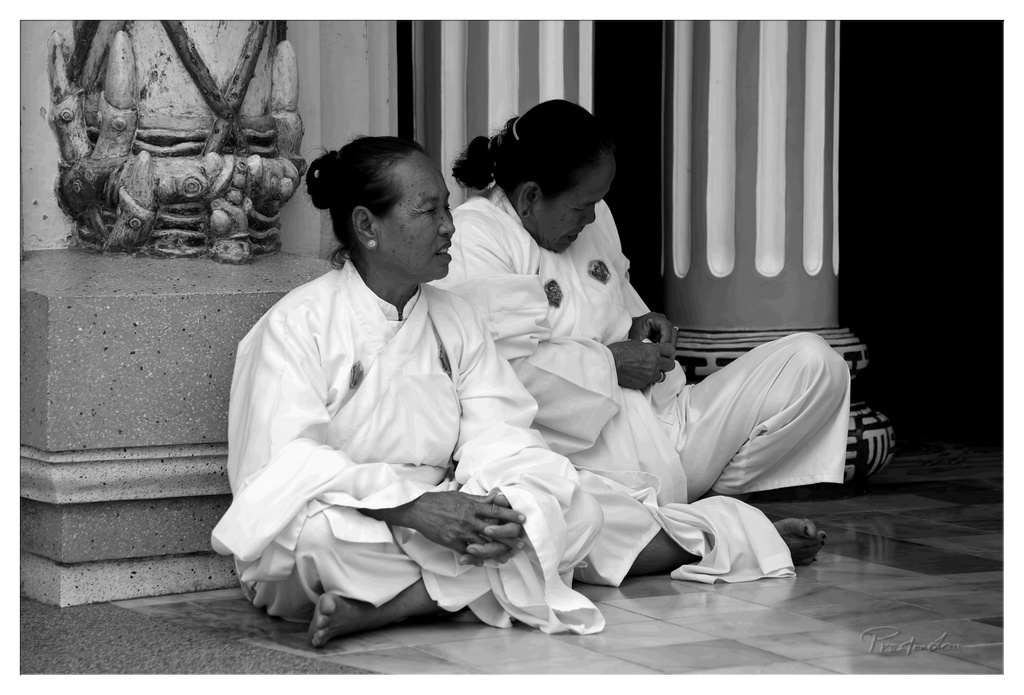

Temple Talk in Monochrome
8/10
In a serene black and white snapshot, two women, likely friends or fellow practitioners dressed in simple, loose white robes, share a moment of quiet contemplation or light conversation. They are seated cross-legged on a cool, geometric-tiled floor, their faces etched with character and life. One woman looks intently at the other, who is focused downwards, perhaps adjusting her clothing or simply lost in thought. The overall mood is one of peace and stillness, capturing a slice of daily life or spiritual practice within what appears to be the grounds of a temple or public building. The monochrome palette strips away distractions, focusing our attention purely on the figures and their interaction.
From a photographic standpoint, the composition places the subjects slightly off-center, grounded by the interesting tiled pattern below and framed by the textured stone base on the left and the distinctive striped columns receding into shadow on the right. The natural lighting is soft and even, beautifully illuminating the white fabric and the women's faces without harsh shadows – a blessing for portraits, unless you're aiming for dramatic chiaroscuro, which frankly would ruin this chill vibe. The choice of black and white enhances the textures of the clothing and the ancient-looking architecture, giving the image a timeless quality. The crop feels a *tad* tight at the bottom, but it keeps the focus squarely on these two lovely individuals. It's a simple yet effective composition that captures a genuine moment, proving you don't need explosive color or dynamic action to make a compelling image. Sometimes, just two people chilling in white robes is enough.
Loading map...